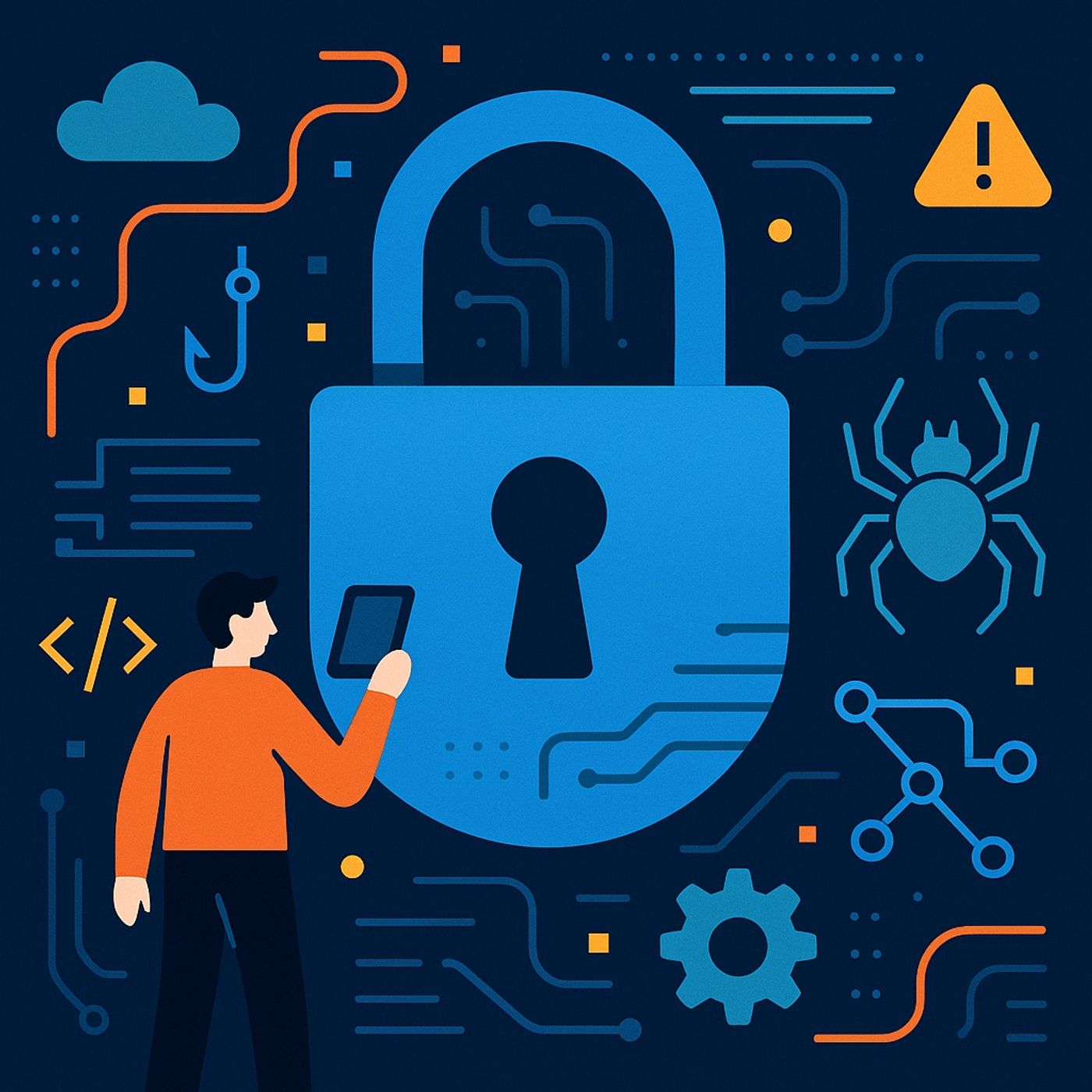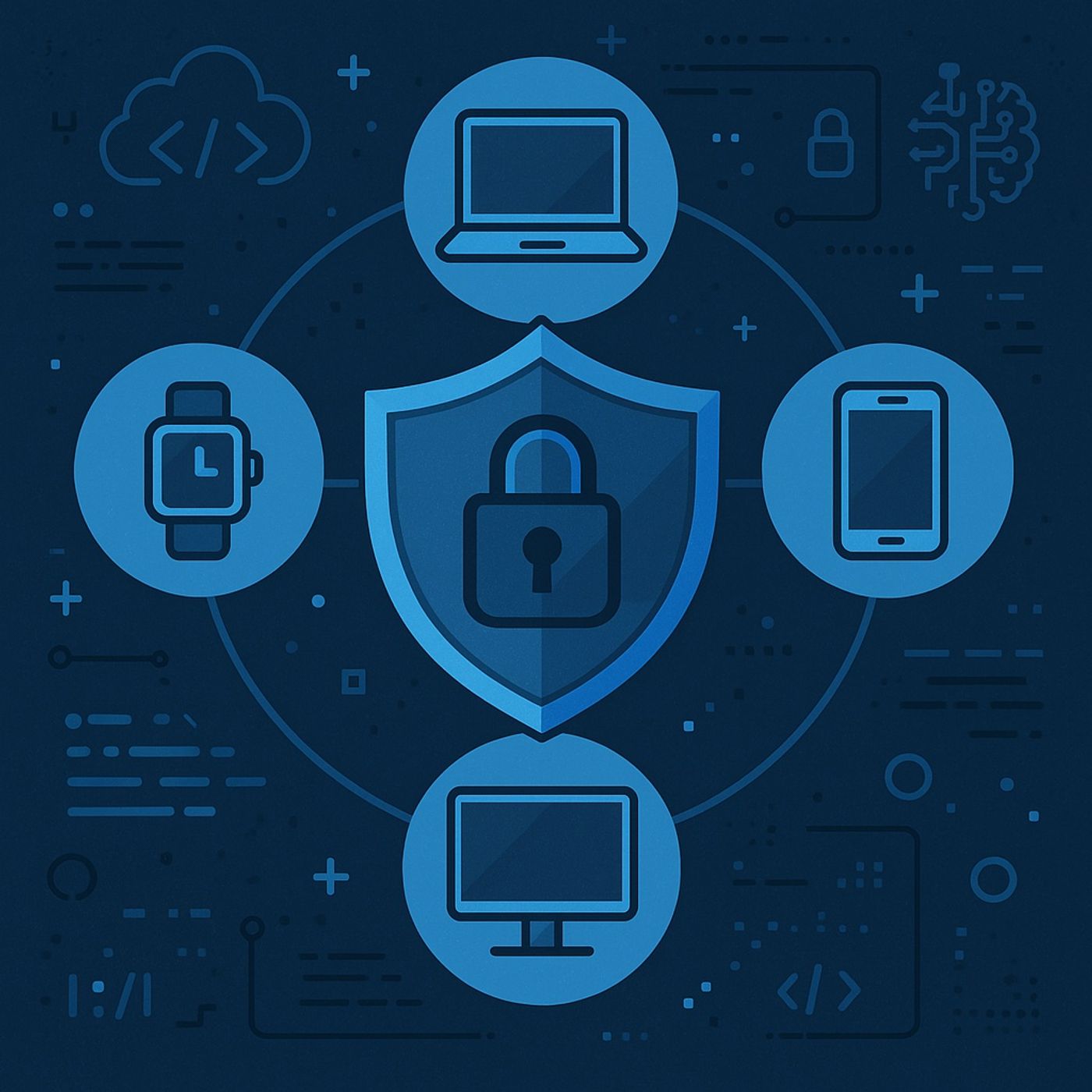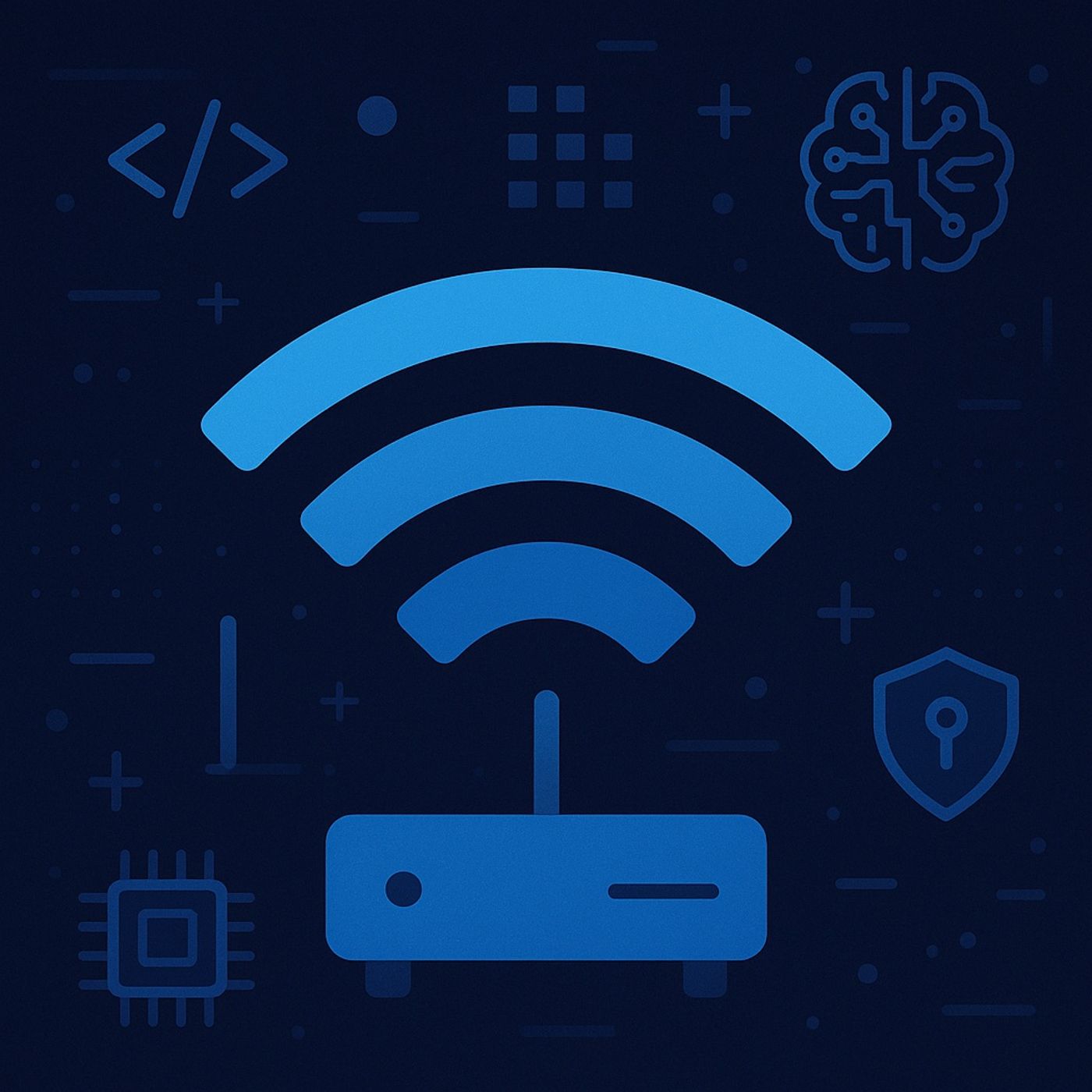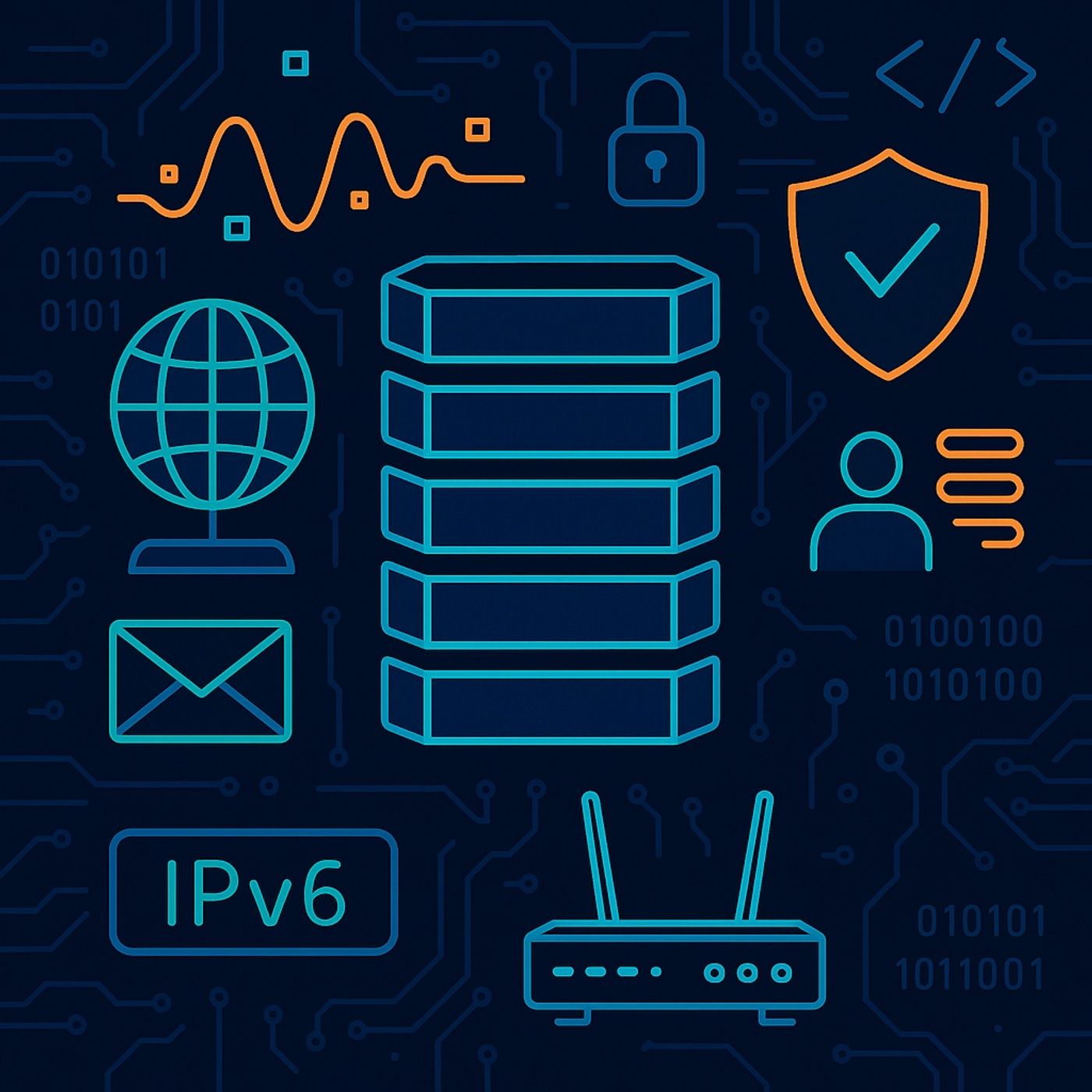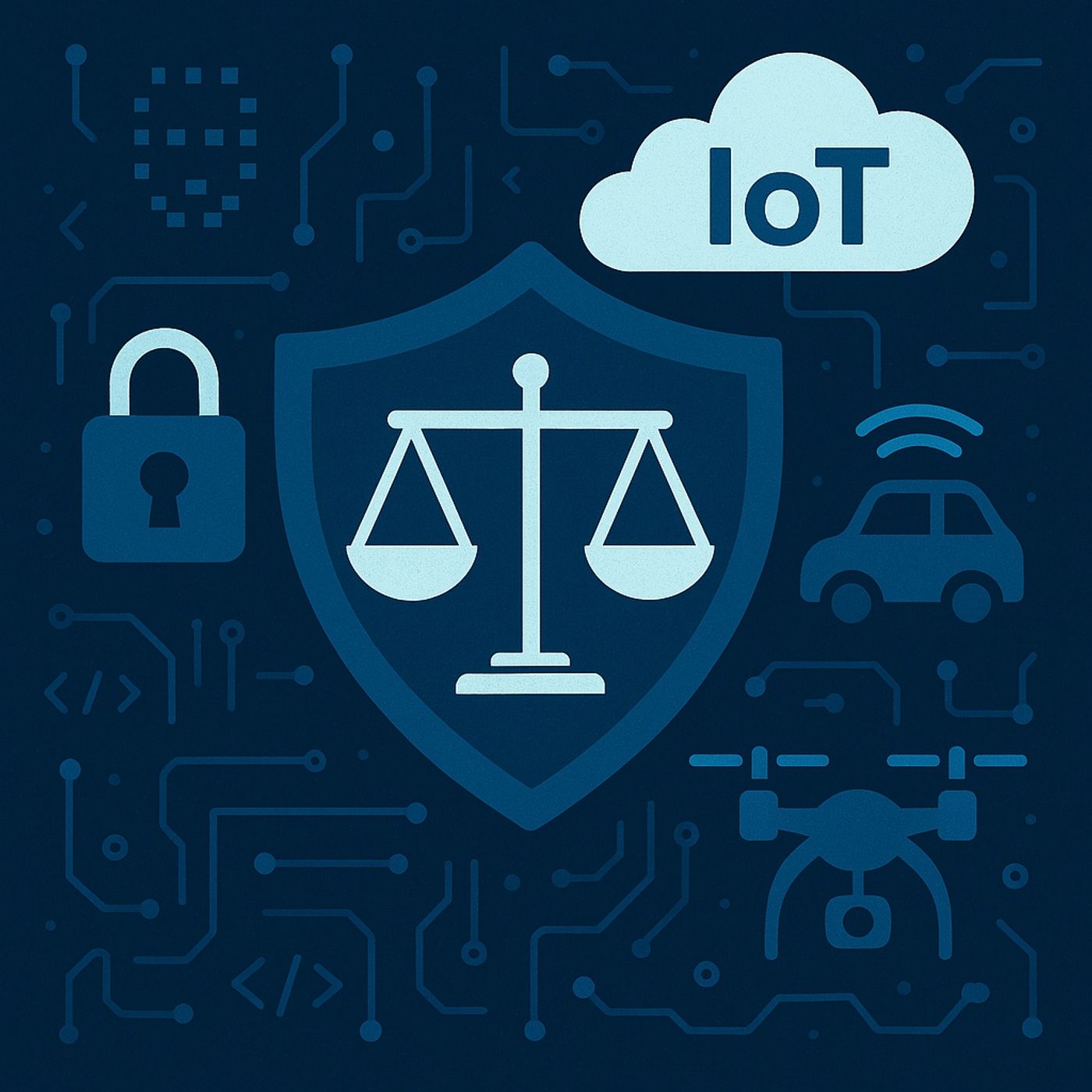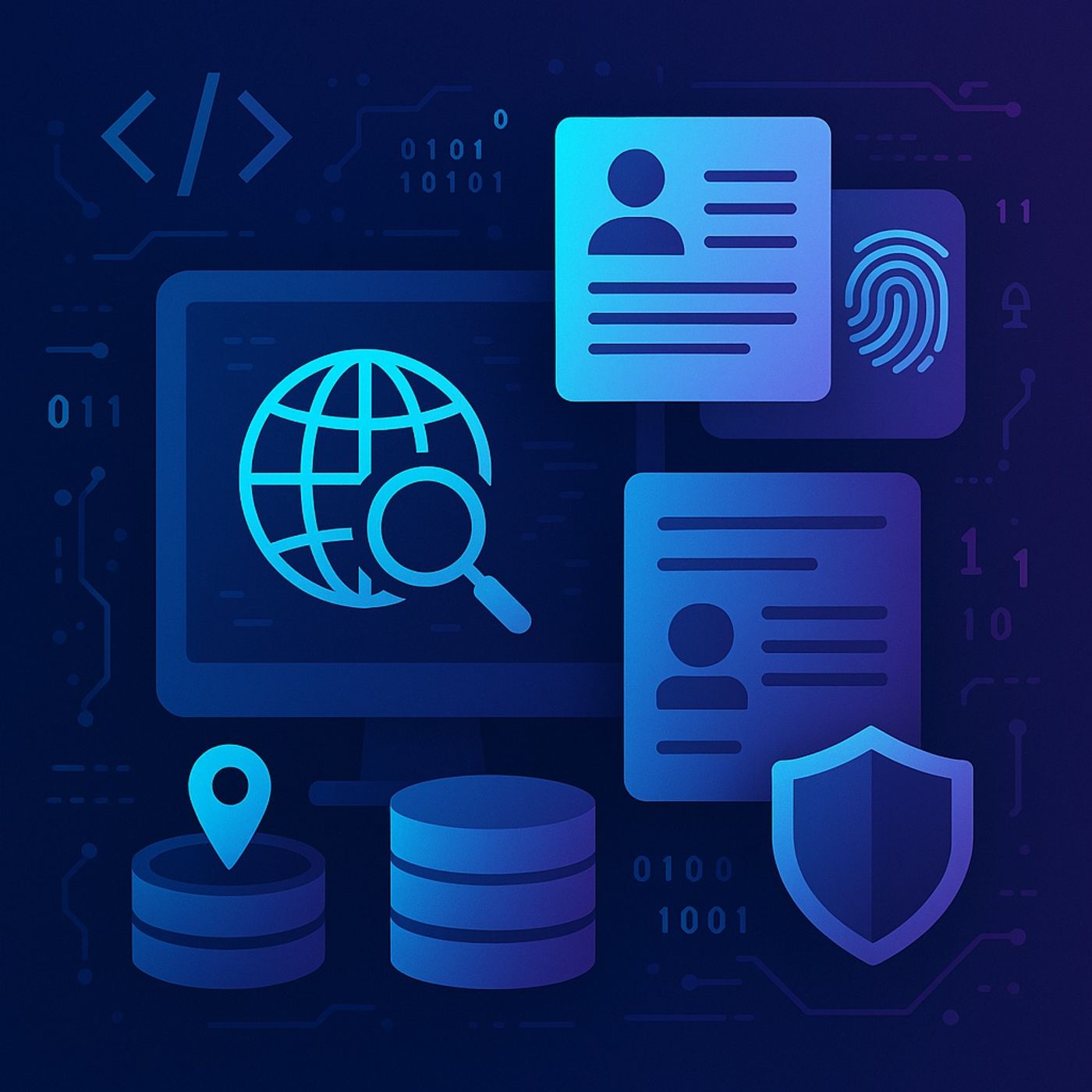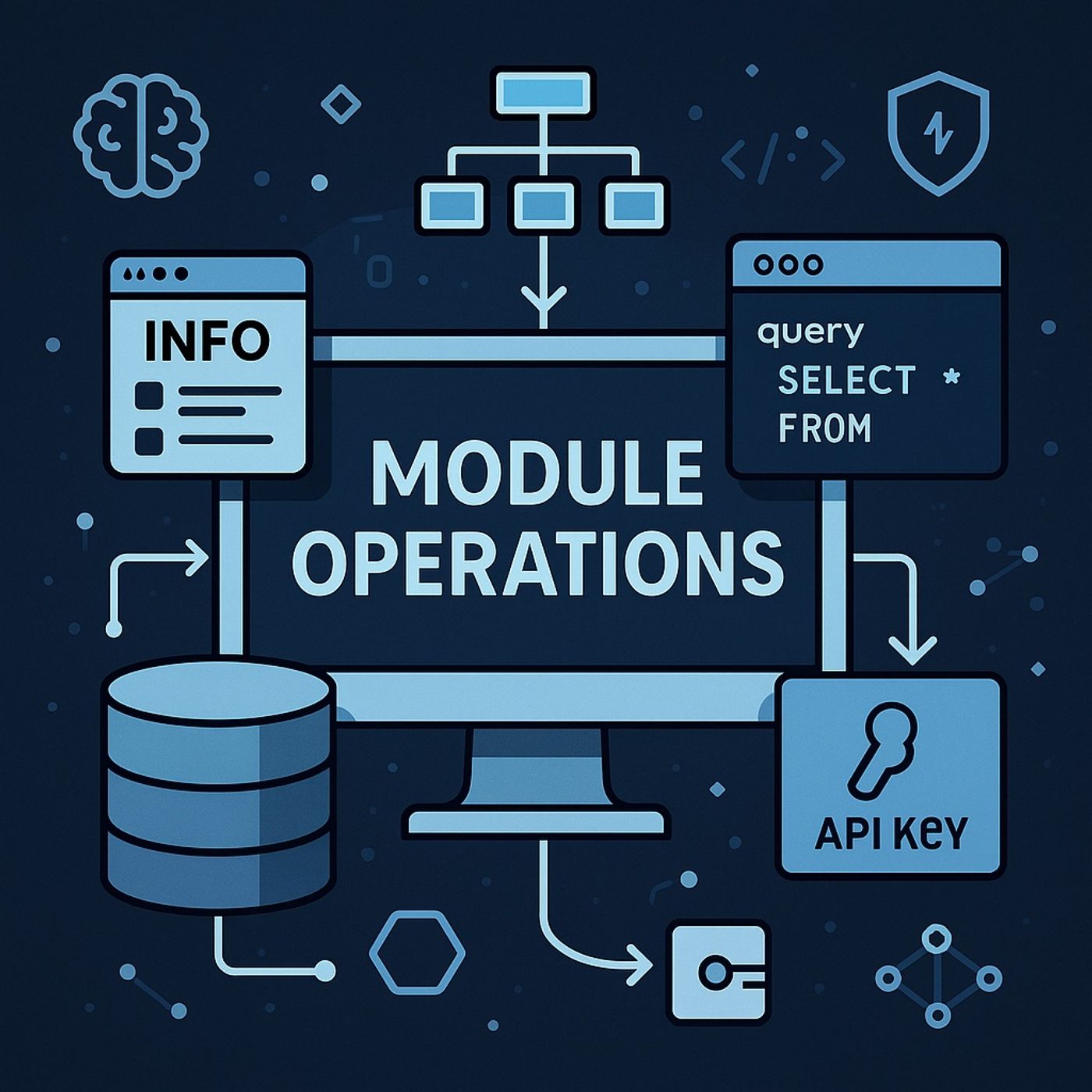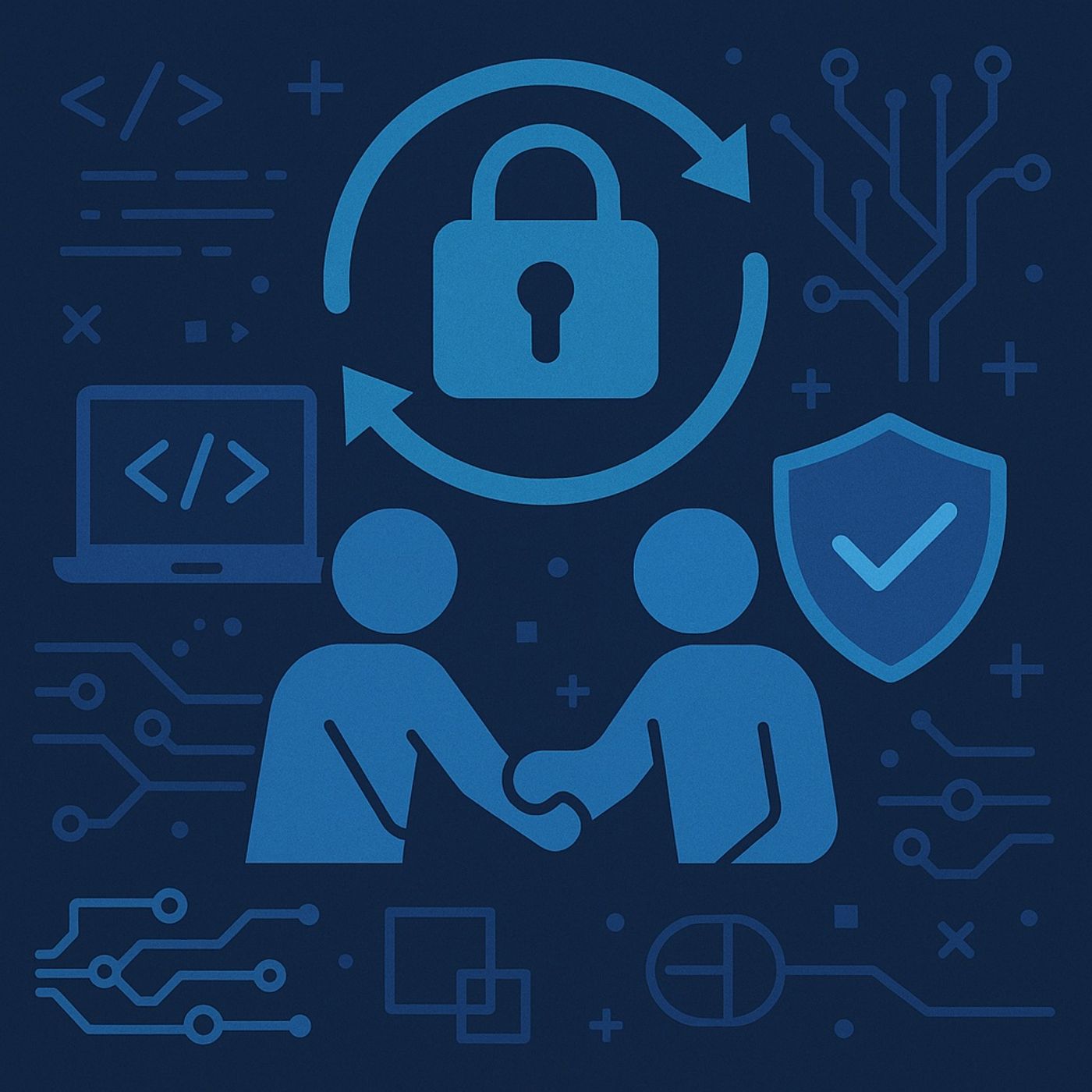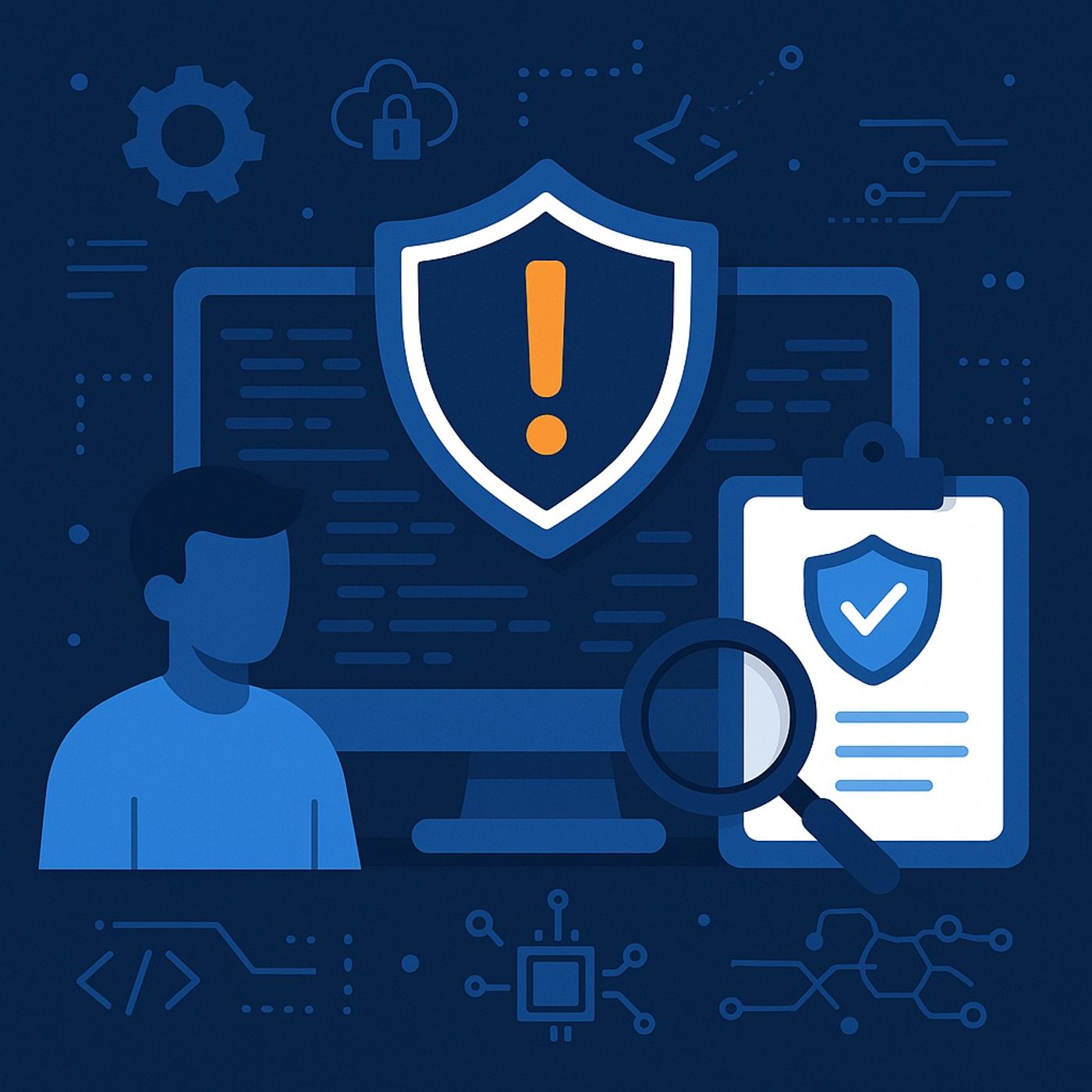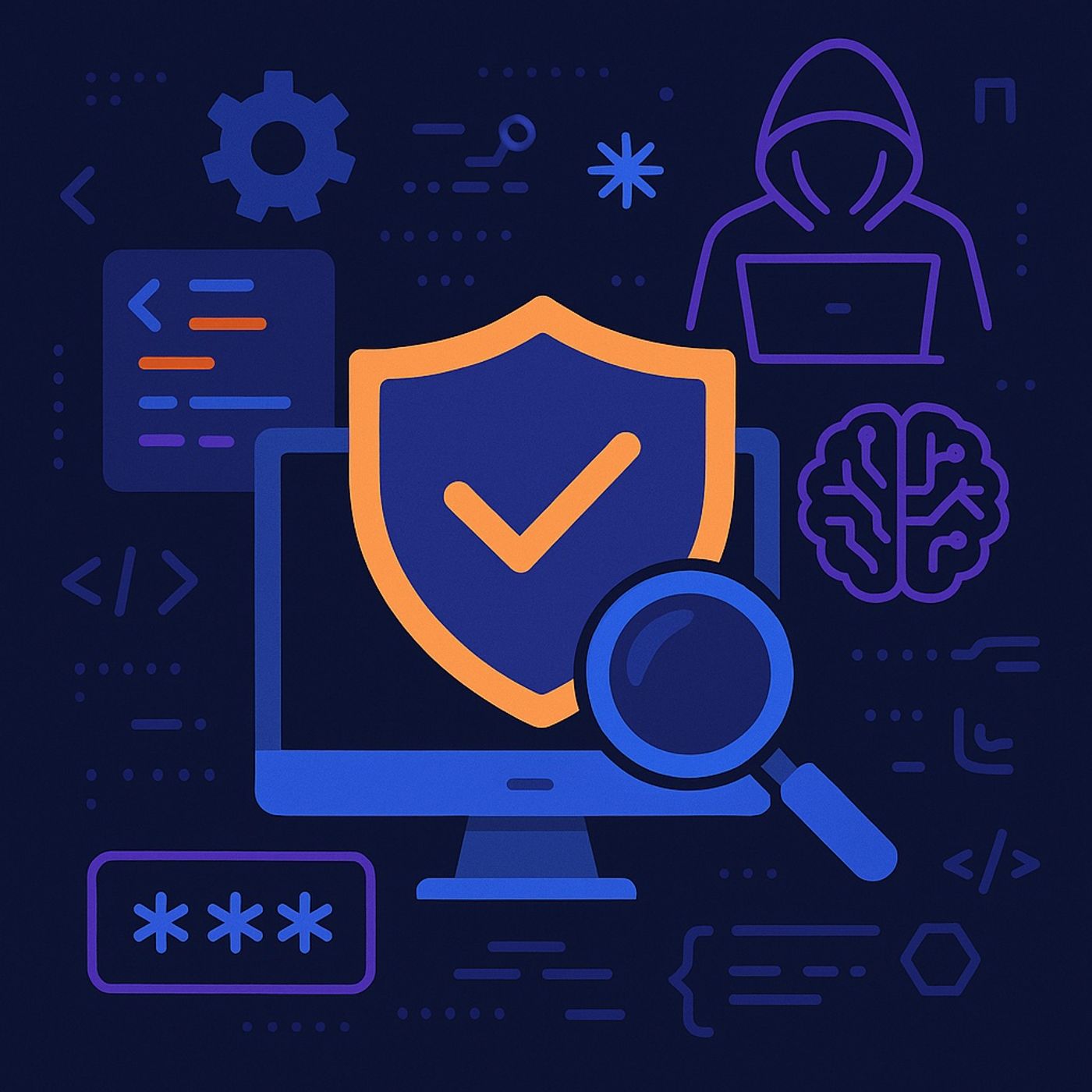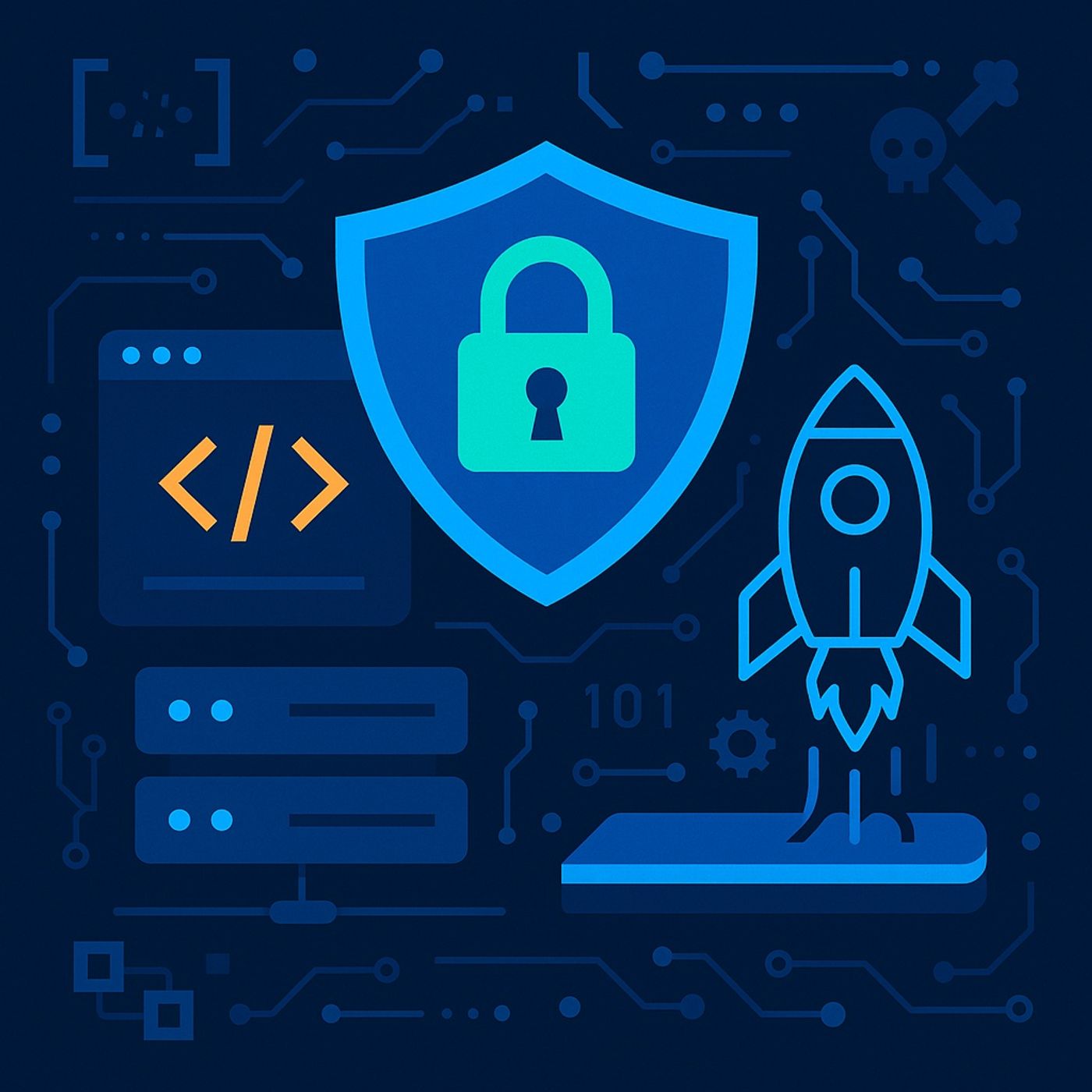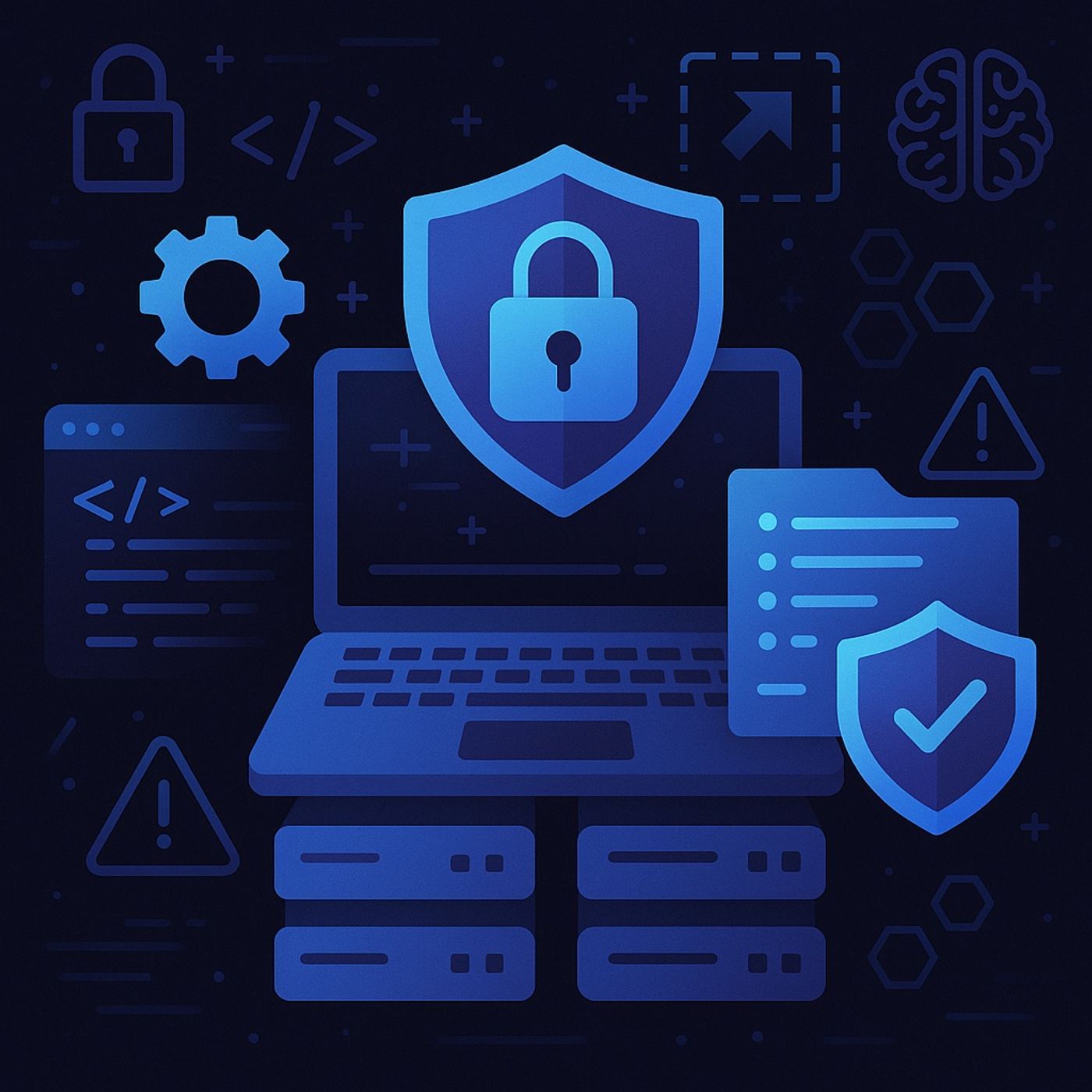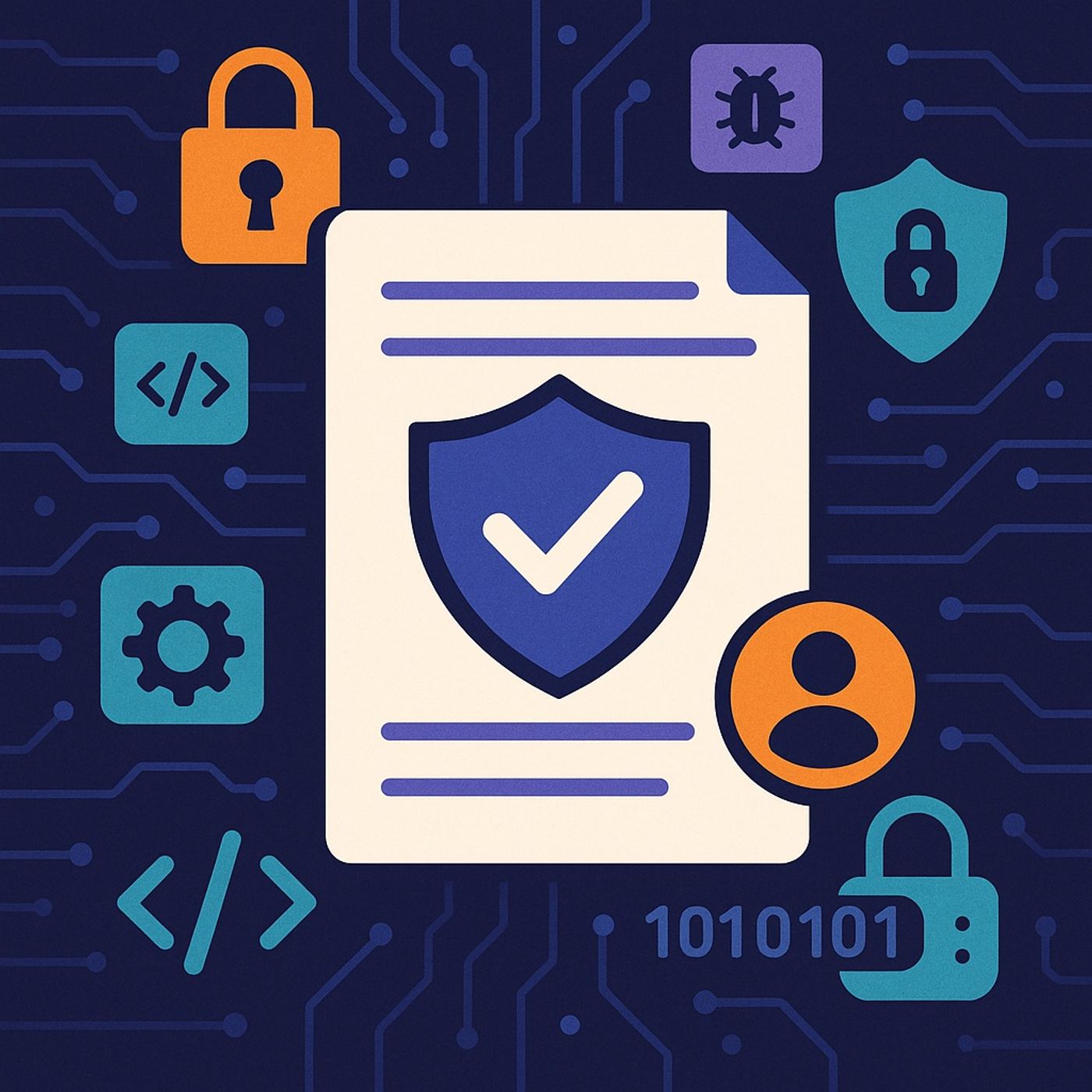Discover CyberCode Academy
CyberCode Academy

CyberCode Academy
Author: CyberCode Academy
Subscribed: 6Played: 0Subscribe
Share
© Copyright CyberCode Academy
Description
Welcome to CyberCode Academy — your audio classroom for Programming and Cybersecurity.
🎧 Each course is divided into a series of short, focused episodes that take you from beginner to advanced level — one lesson at a time.
From Python and web development to ethical hacking and digital defense, our content transforms complex concepts into simple, engaging audio learning.
Study anywhere, anytime — and level up your skills with CyberCode Academy.
🚀 Learn. Code. Secure.
🎧 Each course is divided into a series of short, focused episodes that take you from beginner to advanced level — one lesson at a time.
From Python and web development to ethical hacking and digital defense, our content transforms complex concepts into simple, engaging audio learning.
Study anywhere, anytime — and level up your skills with CyberCode Academy.
🚀 Learn. Code. Secure.
70 Episodes
Reverse
In this lesson, you’ll learn about:Defense in Depth (DiD) and layered security controlsData integrity, backup policies, and encryption best practicesSecuring voice and email communicationsSocial engineering and vishing defensePKI-based email protection (PGP, S/MIME)Zero Trust Networking (ZTN) architecture and IAM principlesCore Principles of Modern Network Security 1. Defense in Depth (DiD) A security strategy based on creating multiple layers of protection so no single failure leads to compromise.Physical Controls: Locks, cameras, facility access controlsAdministrative Controls: Policies, procedures, user awareness trainingPerimeter Controls: Firewalls, filtering devicesInternal Network Controls: Segmentation, monitoring, endpoint securityGoal: an attacker must successfully bypass multiple layers at the same time, reducing overall risk.2. Data Integrity, Resilience, and Backup Strategy A. Data Integrity and AvailabilityData must stay complete, accurate, and accessible.Backup policies must consider the entire data lifecycle.B. Backup and Retention Best PracticesFollow regulatory retention requirements (e.g., financial records retained for 7 years in certain industries).Use reliable storage media and ensure off-site storage for disaster recovery.Employ both:On-site backups for fast recoveryOff-site backups for catastrophic eventsPlan for long-term data growth.C. Encryption for Data at RestConfidential data should be encrypted using strong symmetric algorithms such as AES-256.Protects against physical theft, insider threats, and unauthorized access.3. Securing Voice Communications A. Voice Technologies CoveredVoIP (Voice over IP)POTS (Plain Old Telephone System)Mobile communicationsB. Key ThreatsMan-in-the-Middle (MitM) attacksCaller ID spoofing“Phone phreaking” and unauthorized system accessSocial engineering and vishing attacksC. Hardening Voice SystemsEncrypt voice traffic where possible.Disable unnecessary features on phone systems.Change all default passwords and device settings.Use network segmentation (VLANs/subnets) to isolate voice systems from the main LAN.Users with sensitive communications should use encrypted apps such as Signal.4. Email Security Essentials A. The Need for Encryption Historically, email was transmitted in clear text—making confidential messages vulnerable to interception. B. Two Primary Encryption Systems Both rely on asymmetric PKI (Public Key Infrastructure):PGP / GPG / OpenPGPS/MIME (Secure / Multipurpose Internet Mail Extensions)C. Additional Email ProtectionsOpportunistic TLS for encrypting SMTP connections when possible.SPF (Sender Policy Framework) to validate legitimate email senders.Anti-spam and anti-phishing filters (e.g., Bayesian filtering).User training via phishing simulations to strengthen human defense.5. Zero Trust Networking (ZTN) A. Core Philosophy“Never trust, always verify.”Assume an attacker may already be inside the network.B. Architectural ComponentsStrict verification of every user and device before access is granted.Network segmentation using VLANs and subnets to reduce lateral movement.Identification of the “protect surface” — the most critical data and systems.C. Identity and Access Management (IAM)Strong use of AAA principles:Authentication (verify identity)Authorization (grant the minimum required access)Accounting/Auditing (log all actions)Reduces reliance on perimeter-only defenses.You can listen and download our episodes for free on more than 10 different platforms:https://linktr.ee/cybercode_academy
In this lesson, you’ll learn about:The top real-world network threats and how to think like an attackerThe full process of conducting a vulnerability assessmentTools and methodologies used in modern vulnerability scanningHow penetration testing works and its legal, ethical, and operational requirementsRed team vs. blue team rolesBest practices for reporting and mitigating discovered vulnerabilitiesModern Network Defense Using an Offensive Security Mindset 1. Thinking Like an AttackerDefense is inherently harder than offense, so defenders must understand attacker mindset and methodology.Understanding how attacks work is essential for proper mitigation.A widely referenced list (e.g., from firms like Netrix) highlights the most common network attacks, including:Denial-of-Service (DoS)Man-in-the-MiddlePhishing and spear phishingDrive-by attacksPassword attacksSQL injectionCross-Site Scripting (XSS), CSRF/XSURF variantsEavesdroppingBirthday attacksMalware attacks2. Vulnerability Assessment Vulnerability assessments identify weaknesses in an organization’s systems before an attacker does. Definition and PurposeA structured evaluation of security policies, controls, and system configurations.A combination of automated scanning and manual analysis.Verifies whether an organization’s defenses align with its intended security posture.Assessment StepsNetwork DiscoveryUse tools like Nmap or Zenmap to map the environment.Identify open ports, services, and protocols.Establish scope and baseline information.Vulnerability ScanningDedicated scanners identify known vulnerabilities in devices and applications.Examples commonly used in labs or controlled learning environments include:NessusOpenVASAunetisApplication-level scanners include:Burp SuiteNiktoWapitiSQLMapMany tools are pre-packaged in specialized security testing operating systems (e.g., Kali Linux, Parrot OS).Analyzing and Validating ResultsRemove false positives.Evaluate severity and risk.Determine potential impact and remediation urgency.3. Penetration Testing (Ethical Hacking) Penetration testing goes beyond vulnerability assessment by attempting controlled exploitation in an authorized test environment. PurposeSimulates real-world attacks to evaluate the organization's true security posture.Helps validate defenses, identify exploitable paths, and strengthen systems.Key Components A. Tools and PlatformsSpecialized security operating systems like Kali Linux and Parrot OS.Frameworks such as Metasploit provide structured exploit testing in controlled environments.B. Penetration Test TypesWhite Box: Full internal knowledge (IP ranges, architecture, credentials).Black Box: No prior knowledge, simulating an external attacker.Gray Box: Partial information, simulating an insider or semi-informed adversary.C. TeamsRed Team: Offensive testers simulating adversaries.Blue Team: Defensive personnel monitoring, detecting, and mitigating attacks.D. Legal and Ethical RequirementsA formal contract must define:Scope of testingRules of engagementPermission to perform active testsEnsures compliance with laws (such as the CFAA in the U.S.) and protects testers from liability.E. Final DeliverableA structured professional report including:Executive summaryRisk-ranked list of vulnerabilitiesTechnical analysis and reproduction detailsClear mitigation recommendations for the security teamYou can listen and download our episodes for free on more than 10 different platforms:https://linktr.ee/cybercode_academy
In this lesson, you’ll learn about:Why endpoint security is essential in modern networksKey strategies for protecting endpoints from malware and attacksHardening techniques that reduce the attack surfaceHow Network Access Control (NAC) enhances securityThe role and capabilities of HIDS/HIPSMobile Device Management (MDM) systems and BYOD policiesEndpoint Security — Concepts, Techniques, and Management 1. Why Endpoint Security MattersEndpoint security became critical after the shift from host-terminal systems to distributed client-server environments in the late 1980s.Endpoints now have computational power, making them attractive and vulnerable targets for attackers.Compromising an endpoint is often the easiest way for an attacker to infiltrate the rest of the network.Endpoints requiring protection include:PCs, laptops, smartphones, tabletsSmart TVs, smart watchesE-readers and IoT devices (e.g., HVAC systems, sensors, appliances)To limit lateral movement, organizations must use network segmentation (e.g., VLANs) so that a breach in one segment does not compromise the entire network.2. Core Protection Strategies Anti-Malware DeploymentAnti-malware software must be installed on all endpoints.Automated deployment (e.g., Group Policy) ensures consistency and coverage.All operating systems—Windows, macOS, Linux, Android, iOS, IoT—must be regularly patched.Network Access Control (NAC)NAC enforces security requirements before or during network access.Two main deployment styles:Proactive NAC: Device must have anti-malware and meet security standards before joining the network.Reactive NAC: Device is removed from the network if malware or misconfiguration is detected.NAC strengthens confidentiality and integrity, though proactive enforcement may temporarily reduce availability.HIDS / HIPSFor high-value systems, install:Host-Based Intrusion Detection Systems (HIDS)Host-Based Intrusion Prevention Systems (HIPS)These tools monitor:Logs, configuration changes, system filesSuspicious activity on the hostDesigned to protect critical assets such as servers containing sensitive proprietary data.3. Endpoint Hardening Techniques Hardening reduces attack vectors and decreases the likelihood of compromise.Disable unnecessary services and accountsRemove guest accountsDisable unused protocols (e.g., Telnet)Remove unused or insecure softwareStrong AAA (Authentication, Authorization, Accounting)Enforce password complexity and rotationRestrict permissions to the minimum required (least privilege)Log actions for visibility and auditingSecurity PoliciesAccount lockout after too many failed loginsAutomatic screen lock after 1–2 minutes of inactivityIsolation and EncryptionUse virtualization (VMs) or containers to sandbox risky appsEncrypt data at rest and in transit (e.g., TLS, IPsec)Follow Manufacturer and Industry GuidanceApply security baselinesFollow vendor best practices and secure configuration checklists4. Mobile Device Management (MDM) MDM systems manage mobile devices that often contain both personal and business data. Key MDM capabilities include:Remote WipingErase data from lost or stolen devices to prevent data exposure.Policy EnforcementMandatory screen locksPassword and lockout requirementsApplication ControlWhitelisting: Only approved apps can runBlacklisting: Blocks dangerous or unapproved appsMDM is especially important in BYOD environments, where personal devices access corporate data.You can listen and download our episodes for free on more than 10 different platforms:https://linktr.ee/cybercode_academy
In this lesson, you’ll learn about:What VPNs are and why organizations rely on themHow tunneling works and how VPNs secure data in transitKey VPN protocols (TLS, L2TP/IPsec, AH, ESP) and what each providesHow organizations manage secure remote access for usersAAA systems for authentication, authorization, and auditingAdministrative considerations for supporting remote workers securelyVPNs, Tunneling, and Secure Remote Access — Explained 1. Core VPN ConceptsA Virtual Private Network (VPN) creates a virtual, encrypted connection over an untrusted network (like the internet).VPNs protect communications through:Confidentiality: Encryption hides data from attackers.Integrity: Hashing ensures data isn’t modified.AAA: Authentication, Authorization, and Auditing/Accounting.VPNs are essential for users working remotely, on public Wi-Fi, or in locations with weak security.They defend against attacks such as:Traffic sniffingIMSI-catcher attacks on mobile networksUnauthorized access to internal systems2. Tunneling TechnologyTunneling means encapsulating one network packet inside another using TCP/IP.Encryption can be applied at different OSI layers depending on the protocol.Tunneling allows remote users to securely reach internal networks as if they were physically inside the office.3. Major VPN Protocols A. TLS VPN (Layer 4)Uses Transport Layer Security (TLS) to secure remote access.Accessible through a browser (sometimes called SSL/TLS VPN).Must be protected with account lockout policies to block brute-force login attempts.B. L2TP/IPsecCombines L2TP (Layer 2) for tunneling + IPsec (Layer 3) for encryption.IPsec includes two main components:AH (Authentication Header)Provides integrity, authentication, and non-repudiation.ESP (Encapsulating Security Payload)Provides encryption at Layer 3 so attackers cannot read data.Often used for site-to-site VPNs or permanent remote connections.4. Remote Access RequirementsOrganizations must consider:User bandwidth (slow connections → poor performance).Encryption strength (weak encryption → vulnerabilities).Compatibility with firewall/VPN gateway settings.Monitoring and logging of remote sessions to detect misuse.Remote workers may face obstacles like:Poor-quality internet (e.g., remote regions)Location-based blocks (e.g., Great Firewall of China)5. AAA Systems for Secure AccessAAA = Authentication, Authorization, Auditing/AccountingCommon systems include:RADIUSDiameter (successor to RADIUS)TACACSActive Directory / SSO systems for unified authenticationLogs created during the accounting phase help detect misuse.6. Remote Access Tools Organizations choose tools based on how much access they want to grant:Full desktop control:RDP, VNC, TeamViewer, LogMeIn, Splashtop, CitrixLimited function access (e.g., email only):More restrictive remote gatewaysSecurity teams must:Regularly patch these toolsRestrict access rightsAlign tool capabilities with organizational security goals7. Administrative Policies for Remote WorkersClear rules must define who:Supports equipmentFixes or replaces damaged devicesHandles user connectivity issuesPolicies reduce ambiguity and prevent security gaps.You can listen and download our episodes for free on more than 10 different platforms:https://linktr.ee/cybercode_academy
In this lesson, you’ll learn about:Firewall fundamentals and their evolution across generationsThe role of firewalls in network perimeter defenseIntrusion Detection and Prevention Systems (IDS/IPS) and how they operateDeployment models and detection methods for IDS/IPSBest practices for modern perimeter securityI. Network Perimeter Defense Overview Perimeter defense protects the boundary between an organization’s private network and the public internet. Although external attackers are the main focus, insider threats must also be considered. Firewalls and IDS/IPS systems form critical components of this defense. II. Firewalls: Purpose, Operation, and Evolution What a Firewall Does A firewall filters traffic entering or leaving a private network, blocking malicious or unauthorized traffic while allowing legitimate communication. Firewalls are placed at the network perimeter, between internal systems and the public internet. A firewall is only one layer within a defense-in-depth strategy, where multiple controls work together so that no single point of failure exposes the entire system. Evolution of Firewall Technology 1. First Generation — Packet Filtering Firewall Filters traffic based on simple criteria:IP addressesProtocols (TCP/UDP)Port numbersAlso known as screening routers.2. Second Generation — Circuit-Level Gateway Focuses on the validity of a communication session (“circuit”).Monitors connections to ensure they are legitimate but without inspecting full content. 3. Third Generation — Stateful Inspection Firewall Tracks the state of connections:Remembers which internal device initiated a sessionAllows only expected return trafficProvides more contextual filtering than earlier generations.4. Application-Level Firewall (Proxy Firewall) Operates at Layer 7 of the OSI Model.Filters based on specific applications or internet services (e.g., HTTP, FTP, SMTP).Often used to inspect and regulate user behavior within applications. 5. Next Generation Firewall (NGFW) The modern standard offering advanced, combined capabilities:Packet filteringStateful inspectionDeep Packet Inspection (DPI)TLS proxy and web filteringQuality of Service (QoS) controlsAnti-malware integrationBuilt-in IDS/IPSOrganizations today are strongly advised to deploy NGFWs due to their comprehensive feature set.Firewall Logging All firewalls should:Log events such as configuration changes and rebootsSend logs to a central Security Information and Event Monitoring (SIEM) systemThis ensures proper monitoring, auditing, and investigation of suspicious activity.III. Intrusion Detection and Prevention Systems (IDS/IPS) IDS/IPS technologies monitor network or host activity for signs of malicious behavior. They may be part of a Next Generation Firewall or separate devices. 1. Intrusion Detection System (IDS) A passive monitoring device.Scans for malicious trafficGenerates alerts (email, SMS, console alerts)Allows administrators to investigate manually2. Intrusion Prevention System (IPS) An active security device.Detects malicious activityAutomatically takes action (e.g., blocks ports, drops traffic, changes rules)Essential for mitigating fast-moving attacks like DDoS or ICMP-based floodsCritical note: IPS sensitivity must be configured carefully to prevent attackers from tricking the IPS into shutting down legitimate services. Security as a Service (SECaaS) Organizations may outsource IDS/IPS monitoring to cloud providers.Strong SLAs (Service Level Agreements) are required to ensure:Prompt alertingAccurate monitoringProper response timesIV. IDS/IPS Categories A. Location-Based Systems 1. Host-Based (HIDS/HIPS) Protects individual systems (e.g., critical servers).Monitors:Local firewall logsSystem changesSuspicious local activity2. Network-Based (NIDS/NIPS) Protects the entire network.Monitors traffic flowing through switches, routers, and firewalls.Ideal for detecting lateral movement or perimeter attacks. B. Detection Styles 1. Signature-Based DetectionCompares traffic to known attack signaturesEffective against well-known malware or attack patternsRequires frequent signature updates2. Heuristics / Anomaly-Based DetectionEstablishes a baseline of “normal” network behaviorUses statistical analysis or machine learningFlags deviations that may indicate attacksUseful for detecting zero-day threats and unknown malware.V. Selecting and Deploying IDS/IPS Tools Organizations choose solutions such as:SnortOSSECSolarWinds SEMSelection depends on:Risk assessmentsOrganizational security goalsNetwork architectureCompliance requirementsYou can listen and download our episodes for free on more than 10 different platforms:https://linktr.ee/cybercode_academy
In this lesson, you’ll learn about:Wireless networking standards and operating modesWi-Fi security best practices and hardening techniquesCellular/mobile device threats and defensive controlsCommon wireless attacks and mitigation strategiesI. Wireless Network Standards and Basics Wi-Fi (802.11 Standard) Overview Wi-Fi is based on the IEEE 802.11 family of standards and uses radio waves to transmit data. The most common frequencies are 2.4 GHz and 5 GHz, regulated by authorities such as the FCC. Evolution of Key 802.11 Amendments802.11a: 5 GHz802.11b: 2.4 GHz802.11g: 2.4 GHz (faster successor to 11b)802.11n: Operates on both 2.4 GHz and 5 GHz802.11ac: Supports speeds up to ~1 Gbps802.11ax (Wi-Fi 6): Expected speeds up to ~10 GbpsNetwork Operating ModesInfrastructure Mode: Central router/AP manages communication (default in homes & businesses).Ad-Hoc Mode: Peer-to-peer direct communication without an access point.The network name broadcast by the access point is the SSID (Service Set Identifier). II. Wi-Fi Security and Hardening Practices Legacy Methods to AvoidWEP: Extremely insecure; crackable in under 5 minutes (e.g., via Aircrack-ng).Original WPA: Outdated and vulnerable.Current StandardWPA2-AES: Modern, strong encryption; trusted by government agencies and industry.Critical Hardening TechniquesChange all default settings:Default usernames, passwords, and SSIDs often reveal the device manufacturer and potential vulnerabilities.Use non-descriptive SSIDs:Avoid names indicating location, company, or purpose (OPSEC).Enable 802.1X EAP authentication:Provides strong client verification.MAC Filtering:Restricts access to pre-approved hardware devices. (Not perfect, but adds friction.)Network Isolation:Guest Wi-Fi should be separated from internal corporate networks.Firmware Updates:Essential to patch vulnerabilities (e.g., WPA2 KRACK).Consider alternative firmware such as DD-WRT or OpenWRT.Use WIDS/WIPS:Wireless Intrusion Detection/Prevention systems to monitor or block threats.Emanation Security (MSE):Limit broadcast power to prevent signals from leaking outside the intended perimeter.Consider static IP assignments:Makes it harder for attackers to validate successful infiltration.III. Cellular Networks and Mobile Device Security Cellular ThreatsIMSI Catchers (Stingrays):Fake cell towers used for Man-in-the-Middle attacks, capturing voice, SMS, and metadata.Secure Communication PracticesAlways use end-to-end encrypted protocols, such as:Signal Protocol (Signal, WhatsApp) for calls, messages, and videoStandard voice calls and SMS are unencrypted and easily intercepted.Mobile Device Management (MDM) Organizations use MDM to enforce:Screen lock and passcode policiesApp installation restrictionsRemote wipe capabilityAccount lockout rulesCorporate/BYOD separation of dataLocation Security Control GPS and geotagging to prevent exposure of sensitive operations (e.g., military, law enforcement, executive movement). 5G Concerns Ongoing scrutiny exists due to unresolved privacy and security vetting. IV. Wireless Attacks and Mitigation Strategies 1. Rogue Access Points / Evil Twin Attacks Attack: Fake hotspots mimic legitimate networks to steal credentials or intercept traffic.Mitigation:Employee education about correct SSID namesDisable auto-connect to unknown networks2. WPA2 KRACK (Key Reinstallation Attack) Attack: Exploits the 4-way handshake to reinstall encryption keys.Mitigation:Immediate firmware and OS updates across all vendors3. MAC Address Spoofing Attack: Impersonates a trusted device to bypass MAC filtering.Mitigation:Use stronger authentication (e.g., 802.1X)4. Packet Sniffing Attack: Unencrypted data intercepted over the air.Mitigation:Enforce secure, encrypted protocols end-to-end5. Peer-to-Peer Attacks Attack: Malicious activity from devices on the same local wireless network.Mitigation:Client isolationStrong network segmentation6. Social Engineering Attack: Human manipulation—tricking users into revealing credentials or taking unsafe actions.Mitigation:Security awareness training"Trust but Verify" approach to all requests and identitiesYou can listen and download our episodes for free on more than 10 different platforms:https://linktr.ee/cybercode_academy
In this lesson, you’ll learn about:Networking communication frameworks, including the OSI and TCP/IP modelsIdentity and Access Management (IAM) and the AAA security modelSecure and insecure network protocolsIPv4 and IPv6 addressing fundamentalsI. Networking Models and Communication Frameworks OSI Model (Open Systems Interconnection) — 7 Layers A standardized reference model used globally to explain network communication. Data moves through the layers using encapsulation (adding headers/footers) and de-encapsulation (removing them). Each layer communicates only with its direct neighbors.Layer 1 — Physical:Handles the transmission of bits over physical media (cables, radio waves).Devices: NICs, hubs, repeaters.Layer 2 — Data Link:Responsible for LAN communication using MAC addresses (48-bit hex).Devices: Switches, bridges.Protocols: Ethernet, ARP (maps IP → MAC).Layer 3 — Network:Handles routing and logical addressing.Protocols: IP, IPsec, ICMP.Devices: Routers.Layer 4 — Transport:Handles data delivery using:TCP: Reliable, connection-orientedUDP: Fast, connectionless (e.g., VoIP)TLS/SSL also function here for secure data transfer.Layers 5–7 — Session, Presentation, Application:Session: Controls communication sessions (simplex, half-duplex, full-duplex).Presentation: Formats data (JPEG, MP4, ASCII).Application: Interfaces with the user (HTTP, FTP, email protocols).TCP/IP Model — 4 Layers An older, more practical model used in real networks (ARPANET origin).Layers: Application, Transport, Internet, Link. II. Security and Access Management (IAM & AAA) Identity and Access Management defines how users authenticate, what they can access, and how their actions are tracked. AAA ModelAuthentication (A1):Proving identity, typically via passwords hashed with SHA or MD5 and compared to stored hashes.Authorization (A2):Defines what actions or resources a user is allowed to access.Accounting (A3):Logging and auditing user activity for accountability.Example: Windows event logs for login attempts.Access Control ModelsDiscretionary Access Control (DAC):Users can manage permissions for their own resources (less strict).Mandatory Access Control (MAC):Centralized, classification-based access rules (e.g., “Top Secret”).III. Secure Network Protocols Older protocols often send credentials in plain text and must be avoided. Secure versions provide encryption and integrity.Insecure Protocol (Avoid)Secure Alternative (Use)ReasonHTTPHTTPS (TLS 1.2+)Plain text can be sniffed; TLS encrypts traffic. SSL is outdated.FTPSFTPSFTP uses SSH for secure file transfers.TelnetSSH v2SSH provides encrypted remote administration.POP3 / IMAPPOP3S / IMAPSSecures email retrieval.SNMP v1/v2SNMP v3Adds encryption for management traffic.IV. IP Addressing: IPv4 and IPv6 IPv4Introduced in 1983Uses 32-bit dotted decimal notation (e.g., 192.168.1.1)Address space nearly exhaustedAddress Classes A, B, C for general use (D and E reserved). NAT (Network Address Translation) Used to conserve IPs by translating internal private IPs (RFC 1918 ranges) into a single public address:10.x.x.x172.16–31.x.x192.168.x.xIPv6Introduced in 1996Uses 128-bit hexadecimal notationVirtually unlimited address space → no need for NATCommunication ModesUnicast: One-to-oneMulticast: One-to-manyAnycast: One-to-nearest node among manyAdoption remains slow (~20% globally).You can listen and download our episodes for free on more than 10 different platforms:https://linktr.ee/cybercode_academy
In this lesson, you’ll learn about:The major security challenges and market pressures affecting IoTCommon vulnerabilities and design flaws in IoT devicesReal-world attack case studies demonstrating the risks of insecure IoT systemsBest practices and recommendations for implementing secure IoT solutionsI. Security Challenges and Market PressuresCyber Insurance: The rapid growth of cyber insurance highlights the financial and reputational risks associated with cyber-attacks and IoT data breaches.Balancing Functionality and Security: IoT devices are often rushed to market, creating a trade-off between security, usability, and feature rollout.User Literacy: Lack of awareness or education about security increases risk in a highly connected world.System Design: Security must be integrated from the outset rather than retrofitted after deployment.II. Vulnerabilities and Design FlawsAPI and Storage Issues: Many devices use unsecured local or cloud APIs, store sensitive data unencrypted, or fail to protect collected information.Authentication and Access: Weak or default credentials, exposed network ports, and remote shell access increase the attack surface.Physical Threats: Local attackers can manipulate devices to compromise security.Legacy Threat Transfer: Vulnerabilities common in traditional computing devices (e.g., printers, PCs) often appear in IoT devices.III. Real-World Attack Case StudiesBaby Monitors:Authentication bypass allowed arbitrary account creation without verification.Privilege escalation enabled ordinary users to gain administrative access via URL manipulation.Smart Fridges:Integration with Gmail failed to validate SSL certificates, enabling credential theft.Attackers could monitor networks and potentially access linked email accounts.Smart Vehicles (Autonomous Technologies):Open ports, Bluetooth, and cellular interfaces allowed remote control of critical functions (e.g., transmission, air conditioning, wipers).Findings led to the recall of 1.4 million vehicles, showing the real-world impact of IoT insecurity.IV. Recommendations for Secure IoT ImplementationSecurity by Design: Integrate security during the design phase, not after deployment.Credentials and Authentication: Use complex credentials and disable insecure factory defaults.Network Security: Ensure robust pairing authentication and secure communication channels between devices.Trusted Networks: Limit device connections to a verified set of trusted devices.You can listen and download our episodes for free on more than 10 different platforms:https://linktr.ee/cybercode_academy
In this lesson, you’ll learn about:The rationale for applying legal frameworks to IoTPrivacy, security, liability, contractual, and criminal concerns in IoTExisting UK laws relevant to IoT securityEuropean Union regulations, particularly GDPREmerging regulatory responses to new IoT technologies, such as drones and autonomous vehicles1. Why Law Applies to the IoTPrivacy Concerns: Legal frameworks address collection, storage, and usage of personal data from connected devices, like smart fridges.Physical and Cyber Security: Laws cover malicious acts or mistakes causing harm to systems or individuals, including unauthorized access, firmware tampering, and communication interference.Liability and Blame: Legal provisions determine accountability when IoT-related incidents occur.Agreements and Contracts: Laws govern contracts between companies and end-users regarding shared data access and services.Data Use in Criminal Investigations: Legal frameworks define how aggregated device data can be used as evidence in criminal cases.2. Relevant UK LawsComputer Misuse Act (CMA): Covers unauthorized access and impairment of computers and smart devices. Jurisdiction applies if a crime affects a UK system, regardless of the perpetrator’s nationality.Communications Networks and Services Act: Protects communication systems from interference, including network sniffing.Regulation of Investigatory Powers Act (RIPA): Governs lawful interception of communications and monitors authorized interference by law enforcement.3. European Union RegulationsGeneral Data Protection Regulation (GDPR):Requires companies to implement sufficient security measures for IoT data.Non-compliance can result in fines up to 4% of global turnover or millions of pounds.4. Regulatory Responses to Emerging IoT TechnologiesDrones (UAVs):UK proposes registration and mandatory safety testing due to safety concerns.Contrast with US court ruling that FAA lacked authority over “toy drones.”Autonomous Vehicles:UK government published Eight Principles for Automated Vehicles.The Automated and Autonomous Vehicles Bill addresses liability and insurance issues for self-driving cars, clarifying responsibilities of designers, manufacturers, and users.5. Key TakeawaysExisting IT and cybercrime laws partially cover IoT systems.Cyber-physical IoT systems introduce unique challenges requiring new principles, bills, and regulatory actions.Law plays a crucial role in protecting privacy, ensuring security, and assigning liability in the rapidly expanding IoT ecosystem.You can listen and download our episodes for free on more than 10 different platforms:https://linktr.ee/cybercode_academy
In this lesson, you’ll learn about:The definition and core concept of the Internet of Things (IoT)Key characteristics and capabilities of IoT “things”IoT network types, from small-scale to specialized networksCommon IoT protocols and interfacesIoT architectural models and connectivity methodsReal-world IoT applications and benefits across multiple sectorsSecurity threats and vulnerabilities affecting IoT devices, networks, and dataBest practices and preliminary recommendations for securing IoT systems1. IoT Definition and Core ConceptThe IoT consists of an evolving set of cyber and/or physical entities and networks.“Things” are devices that can be connected, interacted with, and controlled.Core capabilities include: network connectivity, data sensing and storage, computation, communication, autonomous operation, and response to commands.2. IoT Network TypesSmall-Scale Networks: PANs (Personal Area Networks) and BANs (Body Area Networks), e.g., wearables like Fitbits or pacemakers.Localized Networks: LANs (Local Area Networks), WLANs (Wireless LANs), and HANs (Hospital/Home Area Networks).Large-Scale Networks: MANs (Metropolitan Area Networks) and WANs (Wide Area Networks).Specialized Networks: M2M (Machine-to-Machine) networks and Wireless Sensor Networks.3. IoT Protocols and InterfacesIoT leverages standard networking protocols, as well as IoT-specific protocols:RFID (Radio Frequency Identification)MQTT (Message Queuing Telemetry Transport)Bluetooth Low Energy (BLE)Other protocols for IoT-specific communication4. IoT Architectural ModelsDirect Device-to-Device Communication: Example: smart bulb communicates directly with a switch.Local Hub Connectivity: Example: smoke alarm sending data to a local laptop.Gateway-to-Cloud Communication: Example: devices connected via a phone or gateway for cloud-based processing and analysis.5. Real-World Applications and BenefitsSmart Environments: Smart cities (e.g., Singapore, Barcelona), smart homes, and university research labs.Daily Life: Transportation (autonomous vehicles), personal assistants, access control systems, and smart retail (e.g., smart fridges).Health and Wellness: Remote monitoring, elderly “aging in place” support, and wearable fitness trackers.Industry and Finance: Factory floor automation via sensors, financial services personalization, and insurance risk management.6. IoT Security Threats and VulnerabilitiesPhysical or logical infrastructure theft or tamperingData leakage and breachesAuthentication bypass or weak credential managementDenial of Service (DoS) attacksFirmware malware and unpatched vulnerabilitiesHomogeneity of devices increasing systemic riskChallenges with accountability in autonomous systems (e.g., self-driving vehicles)7. Security RecommendationsConnect devices selectively and avoid unnecessary network exposureSegment networks (e.g., separate IoT devices from main networks)Verify and adjust default security settings on devicesSecurely dispose of old devices and sensitive dataMinimize unnecessary communication points to reduce attack surfacesYou can listen and download our episodes for free on more than 10 different platforms:https://linktr.ee/cybercode_academy
In this lesson, you’ll learn about:Managing Recon-ng Data and Generating Stakeholder Reports This episode provides a complete guide to organizing, reporting, and analyzing the large amounts of data collected in a Recon-ng workspace. The emphasis is on converting raw terminal output into structured reports for stakeholders, and performing the necessary strategic analysis before moving forward with later stages of a penetration test. 1. Generating Organized Reports The first priority is exporting Recon-ng data into formats that can be easily consumed by company administrators, security teams, or management. While the internal show dashboard is useful for the tester’s own overview, it is not suitable for stakeholders. Recon-ng offers several reporting modules to solve this: • CSV ReportingThe reporting/csv module generates spreadsheet-style output (compatible with Excel, LibreOffice, etc.).By default, this module exports data from the hosts table.• JSON and XML ReportingThe reporting/json and reporting/xml modules allow exporting data in structured formats.Multiple database tables can be included as needed.These formats are ideal for automated pipelines, dashboards, or integrating with other tools.• HTML ReportingThe reporting/html module creates a ready-to-share HTML report.It includes:An overall summarySections for all database tables that contain dataOptional customization using set creator (your company/organization) and set customer (client name, e.g., “BBC”)This format is suitable for emailing or presenting to non-technical stakeholders.• ListsThe reporting/lists module outputs a single-column list from a selected table.The default column is IP address, but it can be changed (e.g., region, email addresses, etc.).Useful for feeding data into other tools or scripts.• Pushpin (Geolocation Viewer)A more visual reporting option.When latitude, longitude, and radius are set, this module generates HTML files showing pushpins on a Google Maps interface.Useful for mapping physically geolocated server infrastructure.All reports reflect the contents of the currently active workspace, so organizing your data beforehand is important. The Python source files defining each reporting module can be inspected within the Recon-ng home directory if needed for customization or learning. 2. Strategic Post-Scan Analysis (Critical Thinking Phase) After exporting the collected data, the episode stresses that a deliberate analytical stage is absolutely essential. Without it, the reconnaissance effort “is pretty much useless.” This stage involves interpreting the findings and evaluating their security implications. Key analysis areas include: • Infrastructure Weakness IdentificationReviewing BuiltWith data and other technical findings.Understanding the technologies, frameworks, CMS versions, and hosting setups being used.Assessing how an attacker could target these components.• Social Engineering ExposureReviewing publicly accessible HR contacts, admin emails, employee names, and roles.Determining how attackers could misuse this information for phishing or impersonation.• Public Information ScrubbingEvaluating which data points should be removed from public sources.Prioritizing sensitive or high‑risk information that exposes the organization.• Policy and Organizational ReviewDetermining whether internal security policies need updates.Assessing whether operational structures expose unnecessary attack vectors.This stage turns raw data into actionable security recommendations. 3. Next Steps in the Penetration Testing Process Once the reporting and analysis stages are complete, the workflow naturally progresses to the next technical phases: • Vulnerability AssessmentUsing external vulnerability scanners such as OpenVAS.Identifying misconfigurations, outdated software, missing patches, and other weaknesses.• Exploit PhaseAfter identifying vulnerabilities, controlled exploitation attempts are performed.These follow strict ethical guidelines and client permissions.You can listen and download our episodes for free on more than 10 different platforms:https://linktr.ee/cybercode_academy
In this lesson, you’ll learn about: Conducting a Multi‑Stage OSINT Campaign Using Recon‑ng 1. Initial Data Harvesting & Database Population The OSINT campaign begins by creating a dedicated workspace and planning the stages of information gathering. The first objective is to populate core database tables—contacts and hosts. Contact Gatheringwhois_pocs module collects domain registration information, extracting email addresses and owner details.PGP search modules identify additional contacts by searching for PGP keys associated with the target domain.Host Discoverybing_domain_web module scans the domain to enumerate subdomains and hostnames.brute_hosts module brute‑forces common hostnames to uncover additional active hosts not found through search engines.File AnalysisOnce the hosts table is filled, the interesting_files module scans discovered hosts for publicly accessible files such as:sitemap.xmlphpinfo.phpTest filesThese files may contain operational details useful for further analysis.2. Contact Optimization & Breach Assessment This phase enhances collected contact data and checks whether employees or organizational accounts have been compromised. Email Construction Using MangleThe mangle module builds complete email addresses using partial names and organizational naming patterns.It combines first/last names with the domain to produce likely valid addresses.Breach Monitoring Using HIBPhibp_breach module checks if collected or constructed emails were exposed in known credential leaks.hibp_paste module searches paste sites for leaked emails or credentials.Any hits are stored in the credentials table for responsible reporting and remediation.3. Geolocation of Target Servers This stage identifies the physical locations of the target’s online infrastructure. IP ResolutionThe resolve module converts hostnames into IP addresses and updates host entries.GeolocationThe free_geoip module geolocates IPs, revealing the server’s approximate city, region, and country.Location details are appended to the host’s database record.Shodan Integration (Optional)When a Shodan API key is available:Latitude/longitude data is used by the shodan module to gather additional OSINT such as services, banners, and exposed ports.4. Comprehensive Software Stack Profiling The final stage performs a deep analysis of the technologies behind the target website. BuiltWith Technology ScanThe BuiltWith module identifies:Web technologies (e.g., Apache, Nginx, Ubuntu)Infrastructure providers (e.g., AWS)Associated tools (jQuery, New Relic, Analytics services)For large domains, the scan may return hundreds of data points, greatly enriching the OSINT profile.Additional DiscoveriesAdministrative contactsSocial media integrationsCDN detailsHeat‑mapping and analytics tools (e.g., Mouseflow)Optimization platforms (e.g., Optimizely)Summary By the end of this lesson, students understand how to conduct a complete OSINT workflow using Recon‑ng:Populate key database tablesForm accurate contact and host profilesIdentify data breaches ethicallyGeolocate infrastructureProfile the full technology stack of a target domainThis staged approach reflects real-world ethical OSINT methodology and supports responsible security research.You can listen and download our episodes for free on more than 10 different platforms:https://linktr.ee/cybercode_academy
In this lesson, you’ll learn about: Mastering Recon-ng Module Operations, Data Flow, Naming Structure, API Integration & Session Automation 1. Understanding Module Functionality To operate any module correctly, analysts must inspect its requirements using:show info — displays the module’s:NameDescriptionRequired and optional inputsSource and destination database tablesThis command is essential before running any module because it defines what data the module needs and what data it will produce. 2. Data Flow and Interaction Recon-ng modules depend heavily on structured input/output flows:Modules read from specific database tables (e.g., domains, hosts)Then write results to other tables (e.g., contacts, repositories)Understanding this flow is critical for chaining modules efficiently. 3. Module Chaining and Dependency Modules are often dependent on data gathered by earlier modules. Examples:Use a domain enumeration module (e.g., google_site_web)→ populates the hosts tableThen run a discovery module (e.g., interesting_files)→ requires the hosts table to be populated to search for filesThis process is known as module chaining, forming a structured intelligence pipeline. 4. Database Querying Recon-ng allows advanced database searches:query command → perform SQL-like lookupsrun + SQL syntax → filter large datasetsExample use case:Retrieve contacts belonging to one domain instead of dumping the entire contacts table. This improves workflow efficiency when processing large OSINT datasets. 5. Module Configuration Modules can be customized using:set → assign a value (e.g., limit results, pick target subdomains)unset → remove the assigned valueModules also store collected artifacts (such as downloaded files) inside the workspace directory under the .recon-ng path. 6. Module Naming Structure Recon-ng organizes modules into logical categories such as:ReconnaissanceReportingImportDiscoveryThe naming scheme for Reconnaissance modules is especially important:Each module name reflects the source → destination flowExample: domains-hosts means “take domains and discover hosts”Common tables used include:companiescontactsdomainshostsnetblocksprofilesrepositoriesThis structure makes it easy to understand what each module does simply from its name. 7. API Key Management Some modules rely on external APIs (e.g., BuiltWith, Jigsaw). Key commands:keys add → configure an API keyshow keys → list all installed keysWithout keys, these modules will fail or return limited data. 8. Session Scripting & Automation Recon-ng supports automation to streamline repetitive assessments. Tools covered include: a. Command Recordingrecord start → begin recording commandsrecord stop → stop recordingRun recorded script using:recon-ng -r This allows you to reproduce actions automatically. b. Full Session Loggingspool → log everything output in the sessionUseful for audits, reporting, and compliance documentation.Summary This lesson teaches students how to:Understand module requirements (show info)Chain modules effectively using database-driven workflowsCustomize modules with set and unsetUse Recon-ng’s SQL-like querying for precise data extractionManage API keys for enhanced OSINT dataAutomate tasks using recording and spoolingMastering these concepts is essential for efficient Recon-ng usage in real-world penetration testing and intelligence operations.You can listen and download our episodes for free on more than 10 different platforms:https://linktr.ee/cybercode_academy
In this lesson, you’ll learn about: Recon-ng Installation, Shell Navigation, and Data Management for Penetration Testing 1. Installation and Environment Setup Recon-ng is a powerful OSINT framework designed for information gathering in penetration testing. Installation options:Linux (Kali Linux): Pre-installed, straightforward to use.Other Linux (Ubuntu): Clone the repository using Git from Bitbucket; requires Python 2 (Python 3 not supported).Windows or Mac: Run via Docker or a VirtualBox VM.Dependencies: Install Python packages via pip install -r requirements.API Credentials: Initial launch may show errors; these are addressed when configuring modules later.2. Exploring the Special Shell and Data Management After launching, Recon-ng opens a custom shell (not Bash). Key elements: a. CommandsView top-level commands using:helpb. WorkspacesProjects are organized into workspaces.Default workspace is created automatically.Manage workspaces with:workspaces add → create new workspaceworkspaces select → switch workspaceEach workspace contains a hidden folder with:data.db → project databaseGenerated report documentsThe active workspace is shown in the prompt.c. Database StructureAround 20 tables, including:domainscompaniescredentialsTables store critical project data used by modules.d. Adding and Viewing DataAdd data using add :Example: add domains bbc.comExample: add companies ExampleCorpView data using:show domainsshow companiesNote: Creating a workspace uses workspaces add instead of add workspaces.3. Modules and Running Scans Modules are scripts that perform specific reconnaissance tasks. Recon-ng currently has around 90 modules. Workflow:Select module:use Review info:show info → check required settings and usage instructions.Run module:run → uses database data (e.g., domains) for scans.Modules can perform actions like web scans, domain enumeration, or credential searches. 4. Viewing Database via Web Interface Recon-ng provides a web interface via recon-web:Start the server from the Recon-ng directory.Access via: http://localhost:5000 or 127.0.0.1:5000Features: Click a workspace → view database tables and content.5. SummaryRecon-ng organizes projects using workspaces and database tables, enabling structured information gathering.Modules automate reconnaissance tasks using stored data.The custom shell and optional web interface provide flexible ways to manage projects.Understanding workspaces, database tables, and module workflows is critical for effective OSINT and penetration testing.You can listen and download our episodes for free on more than 10 different platforms:https://linktr.ee/cybercode_academy
In this lesson, you’ll learn about: Phase 8 — Collaborative Model & Continuous Security Improvement 1. Overview Phase Eight of the Secure SDLC emphasizes the Collaborative Model, which focuses on addressing security challenges in distributed and enterprise environments. Collaboration strengthens security by bridging gaps between security, IT, and operations teams, breaking down silos, and integrating defense-in-depth strategies. Key success factors include strong stakeholder support for integration, budgeting, and cross-functional alignment. 2. Team Composition and Benefits Security is an ecosystem involving:Macro-level players: Governments, regulators, and standards organizations.Micro-level players: End-users, corporations, and security professionals.Benefits of strong team collaboration:Builds confidence in security programs.Encourages shared responsibility, reducing “it’s not my job” attitudes.Leverages automation (e.g., SOAR) to improve efficiency.Ensures security is user-friendly and effective.Strengthens defense-in-depth strategies.3. Feedback Model Continuous improvement depends on effective feedback, which should be:Timely: Delivered close to the event using real-time metrics.Specific: Concrete, measurable, and aligned with security goals.Action-Oriented: Includes clear instructions for remediation.Constant: Repeated and recurring for ongoing improvement.Collaborative: Employees contribute solutions and insights.4. Secure Maturity Model (SMM) The SMM measures an organization’s security capability and progress through five levels:Initial: Processes are ad hoc, informal, reactive, and inconsistent.Repeatable: Some processes are established and documented but lack discipline.Defined: Formalized, standardized processes create consistency.Managed: Security processes are measured, refined, and optimized for efficiency.Optimizing: Processes are automated, continuously analyzed, and fully integrated into organizational culture.5. OWASP Software Assurance Maturity Model (SAM) SAM is an open framework helping organizations:Evaluate current software security practices.Build balanced, iterative security programs.Define and measure security-related activities across teams.It provides a structured path to improve security capabilities in alignment with business objectives. 6. Secure Road Map Developing a security road map ensures security is aligned with business goals and continuously improved. Key principles:Iterative: Security is a continuous program, regularly reassessing risks and strategies.Inclusive: Involves all stakeholders—IT, HR, legal, and business units—for alignment.Measure Success: Success is measured by milestones, deliverables, and clear security metrics to demonstrate value.7. SummaryPhase Eight emphasizes collaboration and continuous improvement in enterprise security.Security is integrated across all SDLC stages, from requirements to testing.Effective collaboration, feedback, maturity assessment, and road mapping ensure resilient security practices that adapt to evolving threats.This phase is critical because applications are increasingly targeted by cyberattacks, making integrated security essential for organizational defense.You can listen and download our episodes for free on more than 10 different platforms:https://linktr.ee/cybercode_academy
In this lesson, you’ll learn about: Secure Response — SDLC Phase 7 1. Overview Secure Response is Phase Seven of the Secure Software Development Life Cycle (SDLC), focusing on managing security incidents, breaches, cyber threats, and vulnerabilities after software deployment. This phase represents the blue team operations, encompassing monitoring, threat hunting, threat intelligence, and reactive defense measures. The goal is to protect, monitor, and react effectively in a production environment. 2. Incident Management and Response Process A robust Incident Response Plan (IRP) is critical for minimizing damage, reducing costs, and maintaining organizational resilience. The response process is structured in six main steps:PrepareVerify and isolate suspected intrusions.Assign risk ratings.Develop policies and procedures for incident handling.ExplorePerform detailed impact assessments.Detect incidents by correlating alerts, often using Security Information and Event Management (SIEM) tools.Gather digital evidence.OrganizeExecute communication plans to update stakeholders.Monitor security events using firewalls, intrusion prevention systems (IPS), and other defensive tools.Create/Generate (Remediate)Apply software patches and fixes.Update cloud-based services.Implement secure configuration changes.NotifyInform customers and stakeholders if a breach involves personal data.Follow legal and regulatory notification requirements.FeedbackCapture lessons learned.Maintain incident records.Perform gap analysis and document improvements to prevent similar future incidents.3. Security Operations and Automation Operational defenses are typically managed by a Security Operations Center (SOC) or Critical Incident Response Center (CIRC). Core SOC functions include:Identify incidents.Analyze results (eliminate false positives).Communicate findings to team members.Report outcomes for documentation and compliance.Security Orchestration, Automation, and Response (SOAR) enhances efficiency by:Automating routine security operations.Connecting multiple security tools for streamlined workflows.Saving time and resources while enabling flexible, repeatable processes.4. Investigation and Compliance Forensic Analysis is used to investigate and document incidents, often producing evidence for legal proceedings:Digital Forensics: Recovering evidence from computers.Mobile Device Forensics: Examining phones, tablets, and other portable devices.Software Forensics: Analyzing code to detect intellectual property theft.Memory Forensics: Investigating RAM for artifacts not stored on disk.Data Lifecycle Management ensures compliance:Data Disposal: Securely destroy data to prevent unauthorized access. Methods include physical shredding, secure digital erasure, and crypto shredding.Data Retention: Define how long data is kept to comply with regulations like GDPR, HIPAA, and SOX. Steps include creating retention teams, defining data types, and building formal policies with employee awareness.5. Continuous Security Technologies Runtime Application Security Protection (RASP)Integrates directly into running applications to detect and block attacks in real time.Provides contextual awareness and live protection, reducing remediation costs.Can run in monitor mode (detection) or protection mode (blocking attacks).Bug Bounty ProgramsReward external security researchers for reporting vulnerabilities.Benefits include early discovery of security flaws before widespread exploitation.Effective programs define objectives, scope, reward structure, and maintain organizational visibility.6. SummarySecure Response (Phase 7) is essential for post-deployment defense, monitoring, and incident management.Core activities include incident response, SOC operations, automation (SOAR), forensics, compliance, and continuous security.The goal is to detect, mitigate, and learn from incidents while improving overall security posture.You can listen and download our episodes for free on more than 10 different platforms:https://linktr.ee/cybercode_academy
In this lesson, you’ll learn about: Secure Validation — SDLC Phase 6 1. Overview Secure Validation tests software from a hacker’s perspective (ethical hacking) to identify vulnerabilities and weaknesses before attackers can exploit them. Unlike standard QA, which ensures functional correctness, secure validation focuses on negative scenarios and attack simulations, targeting vulnerabilities like SQL injection, cross-site scripting (XSS), and insecure configurations. 2. Key Testing Methodologies Secure validation can be performed manually, automatically, or using a hybrid approach. The main methodologies are: A. Static Application Security Testing (SAST)Type: White-box testingPurpose: Identify vulnerabilities in source code before runtime.Method: Analyze internal code lines and application logic.Tools: Can scan manually, via network import, or by connecting to code repositories like TFS, SVN, Git.Focus: Detect issues such as hard-coded passwords, insecure function usage, and injection points.B. Interactive Application Security Testing (IAST)Type: Gray-box testingPurpose: Continuous monitoring of running applications to detect vulnerabilities and API weaknesses.Features:Tracks data flow from untrusted sources (chain tracing) to identify injection flaws.Runs throughout the development lifecycle.Faster and more accurate than legacy static or dynamic tools.C. Dynamic Application Security Testing (DAST)Type: Black-box testingPurpose: Simulate attacks on running software to observe responses.Focus Areas:SQL InjectionCross-site scripting (XSS)Misconfigured serversGoal: Test behavior of deployed applications under attack conditions.D. FuzzingType: Black-box testingPurpose: Identify bugs or vulnerabilities by injecting invalid, random, or malformed data.Applications: Protocols, file formats, APIs, or applications.Goal: Detect errors that could lead to denial of service or remote code execution.Categories:Application fuzzingProtocol fuzzingFile format fuzzingE. Penetration Testing (Pentesting)Purpose: Simulate real-world attacks to find vulnerabilities automated tools might miss.Phases:Reconnaissance: Gather information about the target.Scanning: Identify open ports, services, and potential attack surfaces.Gaining Access: Exploit vulnerabilities to enter the system.Maintaining Access: Test persistence mechanisms.Covering Tracks: Evaluate if an attacker could erase traces.F. Open Source Security Analysis (OSA/SCA)Purpose: Identify vulnerabilities in open-source components used by the application.Process:Create an inventory of open-source components.Check for known vulnerabilities (CVEs).Update components to patch vulnerabilities.Manage the security response to reported issues.3. Manual vs. Automated ValidationAspectManual ValidationAutomated ValidationExpertiseRequires high domain expertiseEasier for non-expertsSpeedSlow and time-consumingFast and scalableCoverageCan be very thoroughLimited by supported languagesAccuracyAccurate, less false positivesMay generate false positivesBest UseComplex logic, new attacksRoutine checks, high-volume scansRecommendation: Use a hybrid approach, combining both manual expertise and automated tools for comprehensive security coverage. 4. SummarySecure Validation is critical for detecting vulnerabilities before deployment.Techniques include SAST, IAST, DAST, fuzzing, pentesting, and OSA/SCA.Combining manual and automated methods ensures accurate, fast, and comprehensive vulnerability detection.The ultimate goal is to simulate attacker behavior and mitigate risks proactively.You can listen and download our episodes for free on more than 10 different platforms:https://linktr.ee/cybercode_academy
In this lesson, you’ll learn about: Secure Deploy — SDLC Phase 5 1. Overview Secure Deployment focuses on hardening the environment to protect systems from attacks and data breaches. The objective is to develop, deploy, and release software with continuous security and automation. 2. Secure Deployment and Infrastructure Hardening Key practices for secure deployment include:Infrastructure Hardening: Follow CIS benchmarks to reduce risk across hardware and software.Principle of Least Privilege: Grant only necessary access and revoke unnecessary permissions.Access Control: Enforce strong authentication, restrict network access via firewalls, and monitor system access and network IP addresses.Patching and Logging: Apply security patches based on CVE tracking, and implement auditing and logging policies.Secure Connections: Enable TLS 1.2/1.3, use strong ciphers and secure cookies, and implement SSO or MFA as needed.3. Secure DevOps (DevSecOps) DevSecOps integrates security throughout the DevOps pipeline. Key considerations:Automation: Increases efficiency, reduces human error, and ensures consistent security checks.Tool Integration: Combine SAST/IAST and WAFs with issue tracking (e.g., Jira) for continuous monitoring.Compliance Automation: Identify applicable controls and automate compliance measurement within the SDLC.Monitoring Metrics: Track deployment frequency, patch timelines, and the percentage of code tested automatically.4. Secure Container Deployment Containers introduce unique security risks. Recommended practices include:Code Scanning and Testing: Use static analysis tools and check for vulnerable dependencies.Admission Control: Block unsafe container images, e.g., those exposing passwords.Privilege Restriction: Run containers with minimal privileges; avoid root or privileged flags.System Calls and Benchmarks: Limit powerful calls like Ptrace and ensure hosts meet CIS benchmarks for Docker/Kubernetes.5. Web Application Firewall (WAF) A WAF protects web servers by inspecting, filtering, and blocking HTTP traffic at Layer 7.Protection Capabilities: Mitigates threats like SQL injection, XSS, and file inclusion; supports OWASP Top 10 protection.Security Models: Blacklist (negative), whitelist (positive), or hybrid.Deployment Strategy:Ensure WAF meets application security goalsTest alongside RASP or DAST toolsIntegrate with SIEM and security workflowsSupport compliance (PCI, HIPAA, GDPR)6. Secure Review Practices Five key pre-deployment review steps:Gap Analysis: Compare policies against NIST Cybersecurity Framework (Identify, Protect, Detect, Respond, Recover).Privacy Review: Assess potential privacy violations and mitigation strategies.Open-Source Licensing Review: Confirm license compliance and categorize risks (low, medium, high).Security Test Results Review: Address vulnerabilities from SAST, IAST, WAF prior to release.Certify the Release: Document and control software releases using a formal approval process.7. Continuous Vulnerability Management (CVM) CVM ensures ongoing risk reduction by identifying and remediating vulnerabilities continuously:Scanning and Patching: Use SCAP-compliant tools like Nessus, Rapid7, or Qualys; apply updates via automated tools (e.g., SolarWinds Patch Manager, SCCM).Vulnerability Tools: Schedule recurring network scans, define targets, and manage scan plugins to optimize performance.8. SummarySecure Deployment ensures that security is embedded in the release process.Integrates practices from infrastructure hardening, DevSecOps, container security, WAF deployment, secure reviews, and CVM.Moves beyond checklists to continuous, automated risk management, ensuring deployed systems remain secure.You can listen and download our episodes for free on more than 10 different platforms:https://linktr.ee/cybercode_academy
In this lesson, you’ll learn about: Secure Build — SDLC Phase 4 1. Overview Secure Build is the practice of applying secure requirements and design principles during the development phase. Its goal is to ensure that applications used by the organization are secure from threats. Key Participants:Software developersDesktop teamsDatabase teamsInfrastructure teams2. Core Development Practices Secure Coding GuidelinesDevelopers follow standardized rules to ensure threat-resistant code.Security libraries in frameworks are used for critical tasks, such as:Input validationAuthenticationData accessSecure Code ReviewInvolves manual and automated review of source code to uncover security weaknesses.Essential checks include:Proper logging of security eventsAuthentication bypass preventionValidation of user inputFormal Code Review Steps:Source Code Access: Obtain access to the codebase.Vulnerability Review: Identify weaknesses, categorized by risk impact (e.g., financial, reputation).Reporting: Remove false positives, document issues, and assess risk severity.Remediation: Track and fix vulnerabilities using bug tracking systems like Jira.3. Automated Application Security Testing Static Application Security Testing (SAST)White-box testing that scans source code or binaries without execution.Integrates with CI/CD pipelines or developer IDEs for immediate feedback.Supports the “shift left” approach, finding vulnerabilities early in the SDLC.Tools demonstrated: Coverity, LGTMInteractive Application Security Testing (IAST)Gray-box testing performed while the application is running, often during functional tests.Monitors application activity in real-time and pinpoints exact lines of code needing fixes.Advantages:Eliminates false positivesFits Agile, DevOps, and CI/CD workflows4. Third-Party Component Security and Code Quality Open Source Analyzers (OSA) / Secure Component Analysis (SCA)Ensure open-source libraries are current and free of known vulnerabilities.Can integrate with SAST and IAST tools.Resources: OWASP Dependency Check (free tool for detecting vulnerable components).Code Quality ToolsIdentify poor coding practices, dead code, and potential security issues.Improving code quality correlates with enhanced overall security.Tools mentioned: SpotBugs, SonarQube5. SummarySecure Build is Phase 4 of the Secure SDLC.Integrates practices including:Following secure coding standardsPerforming code reviewsApplying automated testing (SAST & IAST)Ensuring component security and code qualityGoal: Proactively address security during development, rather than remediating later.You can listen and download our episodes for free on more than 10 different platforms:https://linktr.ee/cybercode_academy
In this lesson, you’ll learn about: Secure Requirements — SDLC Phase 2 1. Overview of Secure Requirements Definition and Purpose:Secure requirements are functional and non-functional security features that a system must meet to protect its users, ensure trust, and maintain compliance.They define security expectations during the planning and analysis stage, and are documented in product or business requirements.Timing and Integration:Security requirements should be defined early in planning and design.Early integration reduces costly late-stage changes and ensures that security is embedded throughout the SDLC.Requirements must be continuously updated to reflect functional changes, compliance needs, and evolving threat landscapes.Collaboration:Requires coordination between business developers, system architects, and security specialists.Early risk analysis prevents security flaws from propagating through subsequent stages.2. The 20 Secure Recommendations The course details 20 key recommendations, each tied to mitigation of common application security risks. These cover input validation, authentication, cryptography, and more. Input and Data ValidationInput Validation: Server-side validation using whitelists to prevent injection attacks and XSS.Database Security Controls: Use parameterized queries and minimal privilege accounts to prevent SQL injection and XSS.File Upload Validation: Require authentication for uploads, validate file type and headers, and scan for malware to prevent injection or XML external entity attacks.Authentication and Session Management 4–11. Authentication & Session Management:Strong password policiesSecure failure handlingSingle Sign-On (SSO) and Multi-Factor Authentication (MFA)HTTP security headersProper session invalidation and reverificationGoal: Prevent broken authentication and session hijacking.Output Handling and Data ProtectionOutput Encoding: Encode all responses to display untrusted input as data rather than code, mitigating XSS attacks.Data Protection: Validate user roles for CRUD operations to prevent insecure deserialization and unauthorized access.Memory, Error, and System ManagementSecure Memory Management: Use safe functions and integrity checks (like digital signatures) to reduce buffer overflow and insecure deserialization risks.Error Handling and Logging: Avoid exposing sensitive information in logs (SSN, credit cards) and ensure auditing is in place to prevent security misconfiguration.System Configuration Hardening: Patch all software, lock down servers, and isolate development from production environments.Transport and Access ControlTransport Security: Use strong TLS (1.2/1.3), trusted CAs, and robust ciphers to protect data in transit.Access Control: Enforce Role-Based or Policy-Based Access Control, apply least privilege, and verify authorization on every request.General Coding Practices and CryptographySecure Coding Practices: Protect against CSRF, enforce safe URL redirects, and prevent privilege escalation or phishing attacks.Cryptography: Apply strong, standard-compliant encryption (symmetric/asymmetric) and avoid using vulnerable components.3. Mitigation StrategyEach of the 20 recommendations is directly linked to OWASP Top 10 vulnerabilities.Following these recommendations ensures that security is embedded into the SDLC rather than added as an afterthought.This phase emphasizes proactive security design, minimizing risk before coding begins.You can listen and download our episodes for free on more than 10 different platforms:https://linktr.ee/cybercode_academy



